A Furlough in Rome - Part Two
In part one, we left Heinz Thannhauser at the Chiesa Sant’Andrea delle Valle in Rome. He was on a quick furlough visit to Rome, following its occupation by he American army on 5 June 1944. Less than two months later he would lose his life, when he was on the crew of a USAAF bomber which crashed on takeoff in Sardinia.

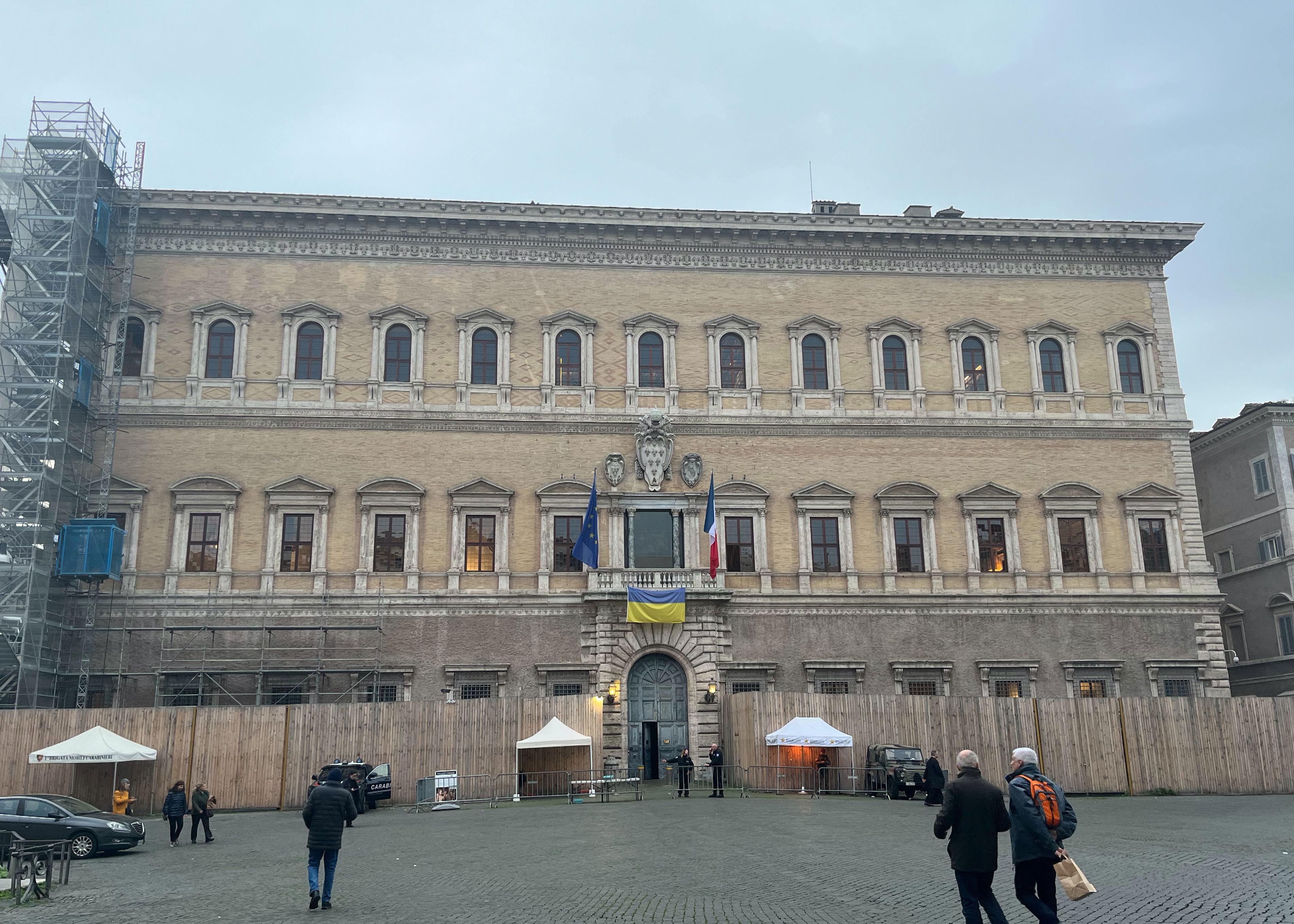
The Palazzo Farnese- currently the French Embassy - under restauro
Heinz’s next stop on his was the Palazzo Farnese, formerly the French Embassy in Rome, it was now temporarily a French headquarters building. It is one of the most important High Renaissance palaces in Rome. First designed in 1517 for the Farnese family, the building expanded in size and conception when Alessandro Farnese became Pope Paul III in 1534, to designs by Antonio da Sangallo the Younger. Its building history involved some of the most prominent Italian architects of the 16th century, including Michelangelo, Jacopo Barozzi da Vignola and Giacomo della Porta. Construction began in 1515 after one or two years of preparation, and was commissioned by Alessandro Farnese, who had been appointed as a cardinal in 1493 at age 25 and was living a princely lifestyle. Work was interrupted by the Sack of Rome in 1527. When, in January 1534 Alessandro became Pope Paul III, the size of the palace was increased significantly and he employed Michelangelo who completed the redesigned third story with its deep cornice and revised the courtyard as well. The post-1534 developments were not only a reflection of Alessandro's change in status but employed architecture to express the power of the Farnese family, much as at their Villa Farnese at Caprarola. The massive palace block and its facade dominate the Piazza Farnese.
After asking some Sudanese guards for directions, a maid showed them into the Galleria. This was the main purpose of his visit , to see the fresco cycle of The Loves of the Gods by the Bolognese painter Annibale Carracci, The palazzo was further modified for the papal nephew Ranuccio Farnese by Jacopo Barozzi da Vignola. It was completed for the second Cardinal Alessandro Farnese by Giacomo della Porta's porticoed facade towards the Tiber which was finished in 1589.
Annibale Carracci was called to Rome in 1594 by Cardinal Odoardo Farnese to decorate the palace.. In the 1580s, Annibale had done various paintings in Parma, the seat of the court of Ranuccio Farnese, Duke of Parma and Piacenza and Odoardo’s brother. In particular, Carracci's first Parma work was a large altarpiece depicting a Pietà with Saints (1585), executed for the church of the Capuchins. After a first brief stay in Rome, in 1595, Annibale took up the service of Cardinal Farnese. The first room in Palazzo Farnese that Annibale decorated was the private studio of Odoardo Farnese, known as the Camerino Farnese, in which he frescoed a cycle with the Stories of Hercules This first task completed, began the decoration of the Galleria The Farnese Gallery is a covered loggia located on the side of the Palace overlooking Via Giulia and the Tiber it is about six meters wide and just over twenty meters long. The room takes light only from one of the long sides (the one overlooking Via Giulia) in which three windows are open and finishes in a barrel vault supported by a series of pilasters. On the long sides there are niches in which some of the famous ancient statues owned by the Farnese family were located. It is not clear what the function of this room was, but it is likely that it was a music hall. In fact, some Farnese inventories attest that musical instruments were placed there.
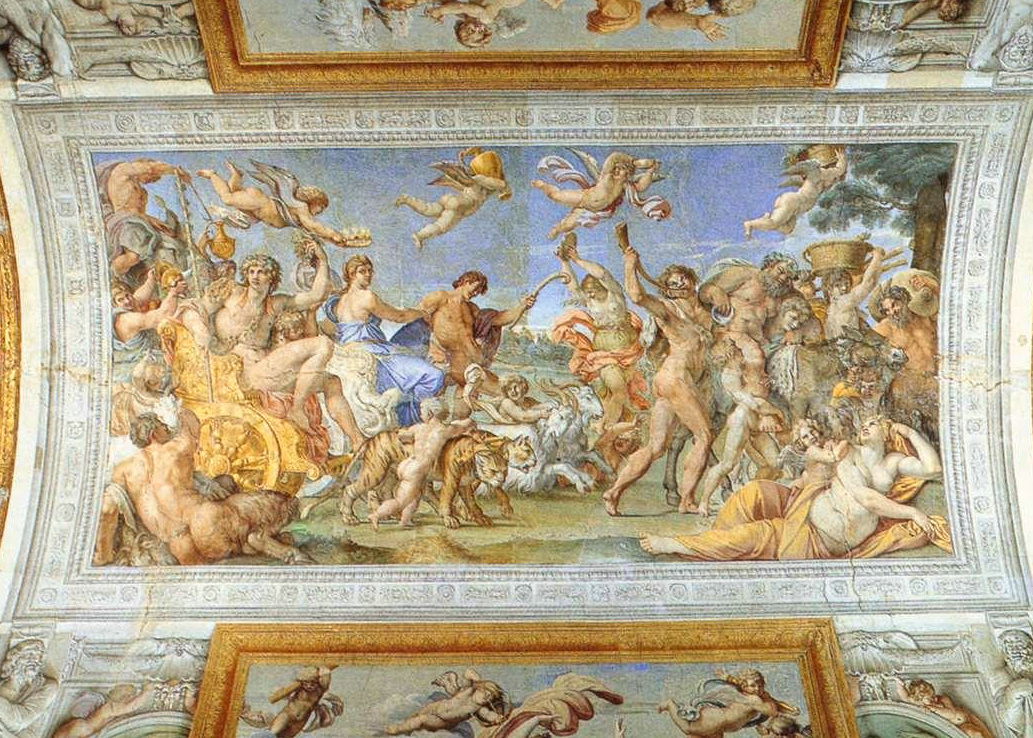
In 1597 Annibale began, with the assistance of his brother Agostino , the decoration of the vault, which is the first section of the Farnese Gallery to have been frescoed The barrel shape of the vault of the Gallery and the need to decorate the central part of the gallery made the scheme of the Bolognese frieze, which presupposes flat walls within a quadrangular room, Hannibal understood that it was necessary to consider other decorative schemes as well. The final result was a combination of three different systems: that of the frieze, the architectural one and that of the paintings carried over, that is, enclosing the frescoed scenes in illusionistic frames as if they were canvases leaning against the wall. To do this, Annibale looked at (and fused together) various examples of ceiling decoration, first of all Michelangelo's ceiling decoration. borrowing the subdivision of space with a fake architecture. On the actual cornice of the Gallery, in fact, Carracci placed a series of herm-telamons (ideal extensions of the real pilasters of the room) which in turn support an illusionistic architrave: elements derived from the painted architecture that divides the Sistine vault. . On the isolated side parts, Annibale grafted a frieze decoration, which is similar to that of the Stories of the Foundation of Rome in Palazzo Magnani in Bologna – and which he nevertheless enriched with a series of decorative elements taken, in part, again from the Sistine vault, such as the vigorous nude young men, who, seated on the cornice, hold a floral garland used as a festoon, and the fake oxidized bronzes that house illusionistic reliefs. In the central part of the ceiling he placed two paintings, while for the main depiction of the entire vault (the Triumph of Bacchus and Ariadne) Annibale used a breakthrough effect that opens the room to the outside. Also on the friezes, both on the long and short sides, there are paintings shown. For these further aspects – i.e. the use of the paintings shown and the insertion of a large scene in the centre of the ceiling – the example followed by Annibale was the decoration of the Bolognese Palazzo Poggi (Stories of Ulysses), made by Pellegrino Tibaldi in the mid-sixteenth century. the use of the painting has a fundamental function in the decorative system of the vault. In this way, Annibale created an imaginary picture gallery for the ancient statues. .that occupied the same room, thus giving the Farnese Gallery a museum-like appearance, evocative of the wealth and refinement of the Farnese family[,.In addition to Michelangelo and Tibaldi, Annibale also referenced the frescoes by Raphael (and his team) with the stories of Cupid and Psyche (Loggia di Psyche), located in the Villa Farnesina. Given its thematic proximity to the undertaking he was about to undertake, Annibale may have also looked to it in order to draw iconographic and compositional solutions,
. The Italian art historian, Giovanni Pietro Bellori summed it up
"Rome can glory in the ingenuity and hand of Hannibal, when by his virtue the golden age of painting is renewed in you."
The story of Bacchus and Ariadne s told in Metamorphoses Bk VIII:152-182 “The Minotaur, Theseus, and Ariadne” is a short section, which sets the scene.
"When Minos reached Cretan soil he paid his dues to Jove, with the sacrifice of a hundred bulls, and hung up his war trophies to adorn the palace. The scandal concerning his family grew, and the queen’s unnatural adultery was evident from the birth of a strange hybrid monster. Minos resolved to remove this shame, the Minotaur, from his house, and hide it away in a labyrinth with blind passageways. Daedalus, celebrated for his skill in architecture, laid out the design, and confused the clues to direction, and led the eye into a tortuous maze, by the windings of alternating paths. No differently from the way in which the watery Maeander deludes the sight, flowing backwards and forwards in its changeable course, through the meadows of Phrygia, facing the running waves advancing to meet it, now directing its uncertain waters towards its source, now towards the open sea: so Daedalus made the endless pathways of the maze, and was scarcely able to recover the entrance himself: the building was as deceptive as that. In there, Minos walled up the twin form of bull and man, and twice nourished it on Athenian blood, but the third repetition of the nine-year tribute by lot, caused the monster’s downfall. When, through the help of the virgin princess, Ariadne, by rewinding the thread, Theseus, son of Aegeus, won his way back to the elusive threshold, that no one had previously regained, he immediately set sail for Dia, stealing the daughter of Minos away with him, then cruelly abandoned his companion on that shore. Deserted and weeping bitterly, as she was, Bacchus-Liber brought her help and comfort. So that she might shine among the eternal stars, he took the crown from her forehead, and set it in the sky. It soared through the rarified air, and as it soared its jewels changed to bright fires, and took their place, retaining the appearance of a crown, as the Corona Borealis, between the kneeling Hercules and the head of the serpent that Ophiuchus holds.!
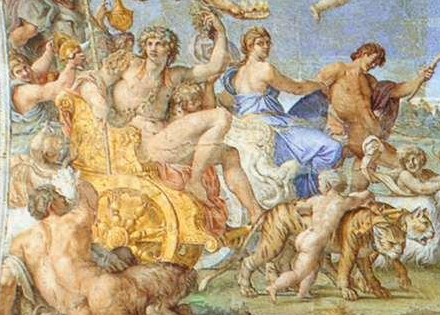
Detail of Annibale Carracci's Triumph of Bacchus and Ariadne. Bacchus is in his golden chariot returning from victory in India. Ariadne who had been abandoned on Naxos by Theseus is her silver chariot having hooked up with Bacchus instead
Ovid’s Ars Amatoria (The Art of Loving)Book 1, Ariadne’s story is retold in a different version. Now Bacchus calls me to his jolly rites:
!"Who would not follow when a god invites?
He helps the poet, and his pen inspires;
Kind and indulgent to his former fires.
Fair Ariadne wander'd on the shore
Forsaken now; and Theseus loves no more;
Loose was her gown, dishevel'd was her hair,
Her bosom naked, and her feet were bare;
Exclaiming, on the water's brink she stood,
Her briny tears augment the briny flood;
She shriek'd and wept, and both became her face,
No posture could that heav'nly form disgrace.
She beat her breast: - "The traitor's gone," said she;
"What shall become of poor forsaken me?
What shall become-" She had not time for more,
The sounding cymbals rattled on the shore.46
She swoons for fear, she falls upon the ground;
No vital heat was in her body found.
The Mimallonian dames about her stood,
And scudding satyrs ran before their god.
Silenus on his ass did next appear,
And held upon the mane (the god was clear).
The drunken sire pursues, the dames retire;
Sometimes the drunken dames pursue the drunken sire.
At last he topples over on the plain;
The satyrs laugh, and bid him rise again.
And now the god of wine came driving on,
High on his chariot by swift tigers drawn.
Her colour, voice, and sense forsook the fair;
Thrice did her trembling limbs for flight prepare,
And thrice affrighted did her flight forbear.
She shook like leaves of corn when tempests blow,
Or slender reeds that in the marshes grow.
To whom the god-" Compose thy fearful mind;
In me a truer husband thou shalt find.
With heav'n I will endow thee, and thy star
Shall with propitious light be seen afar,
And guide on seas the doubtful mariner."
He said; and from his chariot leaping light,
Lest the grim tigers should the nymph affright,
His brawny arms around her waist he threw,
(For gods whate'er they please with ease can do,)
And swiftly bore her thence; th' attending throng
Shout at the sight, and sing the nuptial song.47
Now in full bowls her sorrow she may steep;
The bridegroom's liquor lays the bride asleep.
But thou, when flowing cups in triumph ride,48
And the lov'd nymph is seated by thy side,
Invoke the god and all the mighty powers,
That wine may not defraud thy genial hours.
Then in ambiguous words thy suit prefer,
Which she may know were all address'd to her.
Finally in Ovid’s Fasti Book III, referring to the Calendar , he again tells the story of the Corona Borealis. VII. ID. 8th
"Straightway at the fall of night shalt thou see the Cnossian Crown. ( Cnossian being a reference to Ariadne as a daughter of the King of Cnossos) It was through the fault of Theseus that Ariadne was made a goddess. Already had she happily exchanged a perjured spouse for Bacchus, she who gave to a thankless man a clue to gather up. 48 Joying in her lot of love, “Why like a rustic maiden did I weep?” quoth she; “his faithlessness has been my gain.” Meantime Liber had conquered the straight-haired Indians and returned, loaded with treasure, from the eastern world. Amongst the fair captive girls there was one, the daughter of a king, who pleased Bacchus all too well. His loving spouse wept, and pacing the winding shore with dishevelled locks she uttered these words: “Lo, yet again, ye billows, list to my like complaint! Lo, yet again, ye sands, receive my tears! I used to say, I remember, ‘Foresworn and faithless Theseus!’ He deserted me: now Bacchus does me the same wrong. Now again I will cry, ‘Let no woman trust a man!’ My case has been repeated, only the name is changed. Would that my lot had ended where it first began! So at this moment had I been no more. Why, Liber, didst thou save me to die on desert sands? I might have ended my griefs once and for all. Bacchus, thou light o’ love! lighter than the leaves that wreathe thy brows! Bacchus, whom I have known only that I should weep! Hast thou dared to trouble our so harmonious loves by bringing a leman before mine eyes? Ah, where is plighted troth? Where are the oaths that thou wast wont to swear? Woe’s me, how often must I speak these self-same words! Thou wast wont to blame Theseus; thou was twont thyself to dub him deceiver; judged by thyself, thine is the fouler sin. Let no man know of this, and let me burn with pangs unuttered, lest they should think that I deserve to be deceived so oft. Above all I would desire the thing were kept from Theseus, that he may not joy to know thee a partner in his guilt. But I suppose a leman fair has been preferred to dusky me: - may that hue fall to my foes! But what does that matter? She is dearer to thee for the very blemish. What art thou about? She defiles thee by her embrace. Bacchus, keep faith, nor prefer any woman to a wife’s love. I have learned to love my love for ever. The horns of a handsome bull won my mother’s heart, thine won mine. But my love was cause for praise: hers was shameful. Let me not suffer for my love; thou thyself, Bacchus, didst not suffer for avowing thy flame to me. No wonder that thou dost make me burn; they say thou wert born in the fire and wert snatched from the fire by thy father’s hand. I am she to whom thou wert wont to promise heaven. Ah me! what guerdon to I reap instead of heaven!” She finished speaking. Long time had Liber heard her plaint, for as it chanced he followed close behind. He put his arms about her, with kisses dried her tears, and “Let us fare together,” quoth he, “to heaven’s height. As thou hast shared my bed, so shalt thou share my name, for in thy changed state they name shall be Libera; and I will see to it that with thee there shall be a memorial of thy crown, that crown which Vulcan gave to Venus, and she to thee.” He did as he had said and changed the nine jewels of her crown into fires. Now the golden crown doth sparkle with nine stars.
So Ariadne was alone on Naxos having been deserted by Theseus, when Liber Bacchus/ Dionysus arrives on his way back from his successful campaign in India, he arrives on his chariot pulled by Tigers from India . Also on the scene is Silenus . Bacchus’s older tutor and companion, with his retinue of drunken satyr,
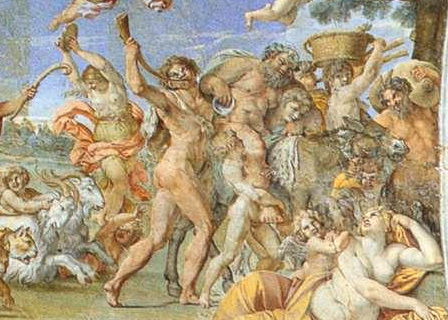
Detail of Annibale Carracci's Triumph of Bacchus and Ariadne. Bacchus's mentor and sidekick Silenus havng a drunkenly good time with some satyrs and nymphs
The Italian art historian Gio Pietro Bellori in volume 1 of his Vite dei pittori, scultori ed architetti moderni descritte da Gio. Pietro Bellori, devotes a chapter to Annibale Carracci in which he sets the scene for the Triumph of Bacchus and Ariadne;
“ When Bacchus returned victorious from the Indies, he found Ariadne abandoned by Theseus, and inflamed by her beauty he chose her as his bride. The painting invites us to admire her now at the triumphal wedding. Bacchus sits in a golden chariot victorious over the Indians; crowned with vine leaves he places his arm and holds the thyrsus like a sceptre with his right hand, and raises his left, making a show of the ripe and red grapes. He is so delicate and soft that, barely holding his raised arm, he comes out under the head of a satyr, who supports him in the noble carriage like an oval seat, in such a way that it does not conceal any part of his beautiful naked body from view; a leather belt, is knotted at the chest, and his right shoulder distinguished with the tiger skull. Bacchus, in sweeping his face and chest forward, exposes his thigh in profile, and raises one knee, lowering the other with his leg, and his foot on the rudder of the golden chariot, in which goats are sculpted, and putti among the vines, and the branches of the grapes. On the left side of Bacchus, Ariadne passes in a silver chariot, where she longingly sits, and raises herself, exposing her naked shoulder, her face, no longer tearful and sad, due to Theseus' infidelity, but serene and happy with her celestial lover*She places her right hand on her left knee, which rises, and so much majesty and grace exudes in her gesture that she seems lifted in herself; and in her divinity, , her celestial coloured skirt is revealed, and her love, which holds the crown of stars above her hair, shines in Heaven because of her. Bacchus' chariot is pulled by the tigers tied to the yoke: a little satyr turns his back, and places one arm on the back of a tiger, and with the other hand lifts the reins from his neck. Ariadne's chariot is pulled by unbridled goats, where a child, pressed to the ground, shelters himself with his hand, and another behind pulls the goat's hair to hold them back. Silenus precedes the pomp on a donkey crowned with ivy: he can be recognized by his face, his bald head, and his belly, falling intoxicated and hesitant; a cup hangs from his right hand, and bends his elbow on the shoulder of a Faun, who blows a resounding cornet. You see him in front completely naked with wild skin knotted on his chest, and ready for various movements; he supports Silenus from behind the shoulders with his left hand, and overwhelms himself on the right, raising his arm and his horn, and puffing out his cheeks: a quick figure infused with spirit. Another young satyr precedes him, who, placing his shoulder under Silenus' thigh, embraces his leg and supports him; and just as Annibale's mind is admirable in finding the proper form of each one, so he advanced in this, having represented him as a rustic, quick young man, and in the first vigour of his immature age. Nor on the other side does the drunken old master remain abandoned; since he leans and leans on the shoulder of a young man, embracing him around the neck; nor can we see anything of the young man other than his face inclined outside the arm of Silenus, which surrounds him; the rest of the body hides only as far as the feet advance on the ground on their plane distant from the first figures. A Satyr ahead leads the donkey, and carries the skin full of wine on his left shoulder, ready to fill the cup and recreate Silenus; and turns to the growl of his, holding him under his neck tied to a string of green ivy; and this figure is somewhat lost in the extremity of the painting. Between Silenus and the Satyr, a Bacchante intervenes, carrying on her head the sacred basket of Bacchus, from which the calf's leg emerges as a sign of Pentheus' punishment; she overwhelms her face, and barely appears with her shoulder, and with her bare arm, in raising her hand to the mysterious basket; and behind it you can just see the profile of a young man, who gives breath to a double tibia, matching the sound and the voices of the Bacchante Choir. But in the foreground ahead of her, a half-naked woman lies on the ground, raised with her right arm bent on a balcony, holding her head on her hand; and as if shaken from sleep by the noise of her, she turns her face towards Silenus, who comes towards her, and looks at her. This is vulgar and earthly Venus, standing next to her is impure Love, who gathered her arms, she leans over her shoulder; she has revealed her chest and breasts, and extends her left hand, taking her mantle on the ground, which covers the rest of her body; and vague is the gesture of the whole figure in slightly raising one knee, extending the other leg in front, and her foot, which comes out of the cloak of a light yellow colour changing into dark purple; and her turning towards Silenus denotes the correspondence between drunkenness and lasciviousness. On the opposite side, near the wheels of Bacchus' chariot in the foreground, a Satyr sits sideways and bends, exposing his shoulders; with his right hand he embraces the neck of a goat, and brings it closer to kiss it; he places his left roan on the ground, but it is cut with her arm in the other extreme line of the picture. Above the horned forehead of the goat itself, and behind the chariot of Bacchus, a boy appears, carrying a vase on his shoulder, and above it a young Bacchante shakes the cymbals, formed in two copper shields, with both hands. , overwhelming the happy and laughing face. At the top advances the head of an Elephant, and his governor on his neck, who holds him, with the rod as a sign of Bacchus' return from the Indies; and these two figures still cut somewhat at the extreme line. Between the choir of Bacchus and Silenus, where the tigers and goats are tied to the chariots of Bacchus and Ariadne remains on a distant view, interposing a little further inside a Faun and a Bacchante. The rustic satyr dances, and as he jumps he shakes his head, and shakes the twisted stick with his left hand, and waving a cloth from his arm, holds it behind him with his right hand: and the Bacchante, also jumping, and twirling, raises her arms above her head , and shakes his resounding timpani in the air, his chest naked, his hair and clothes blowing in the wind. Thus proceeds, and the wedding choir trembles, to the din of the Bacchantes, and in truth the painting excites the dances, and the sound, expresses the fury and sweet insanity, which usually occupies the spirits taken by wine. Three little cupids fly in the air; the first carries the vat of grapes on his head, the second has a cup in his hands, and the third carries a vase on his shoulder. Some drawings of ancient marbles and Bacchanals by the hand of Annibale have been seen for the study of this graceful and copious composition; and the first invention is preserved in our books, with the drunken Bacchus supported by the Fauns on the chariot among the Bacchae, who he changed by forming him into majesty, and more appropriately attributing the drunkenness to Silenus: the figures of the first floor in front, that is Venus and the Satyr, who lie on the ground, are in proportion over eleven palms, and the latter of the Chorus of Bacchus and Silenus are decreasing two palms, and so the others with their size. We have a beautiful anachronism in that fable, since Ariadne is crowned with stars; and the poets imagined that after her death, her hair was placed in memory by Bacchus in heaven; but Annibale made use of such a noble symbol, followed by other painters, and by Guido Beni in the same fable.”
The many reproductions of the Farnese cycle are a sign of the success of the work. The first collections of engravings taken from the Gallery were patronized, between the fourth and fifth decades of the seventeenth century, by Cardinal Armand-Jean du Plessis de Richelieu, the French ambassador housed in the Palazzo Farnese, and were executed by his compatriots. The diffusion of printed illustrations of Annibale's frescoes helped to spread his fame throughout Europe, with a team of French painters making a large series of copies of Farnese's frescoes that were used to decorate a room in the Parisian Royal Palace itself, namely the Gallery of Diana (or of the Ambassadors).Between the end of the eighteenth century and for most of the nineteenth century, the overall critical fortune of Annibale Carracci, and with it that of the Farnese Gallery, declined greatly overshadowed by the accusation of eclecticism. The critical recovery of Farnese's frescoes, and of Annibale's artistic value in general, took place only in the twentieth century.
In 1874 , the building had been leased to the French Government, who subsequently purchased it. Then the Italians purchased it back again and leased it to the French. It is still today the French Embassy, so you cannot just walk in. you have to book a guided tour and you definitely cant take photographs inside.
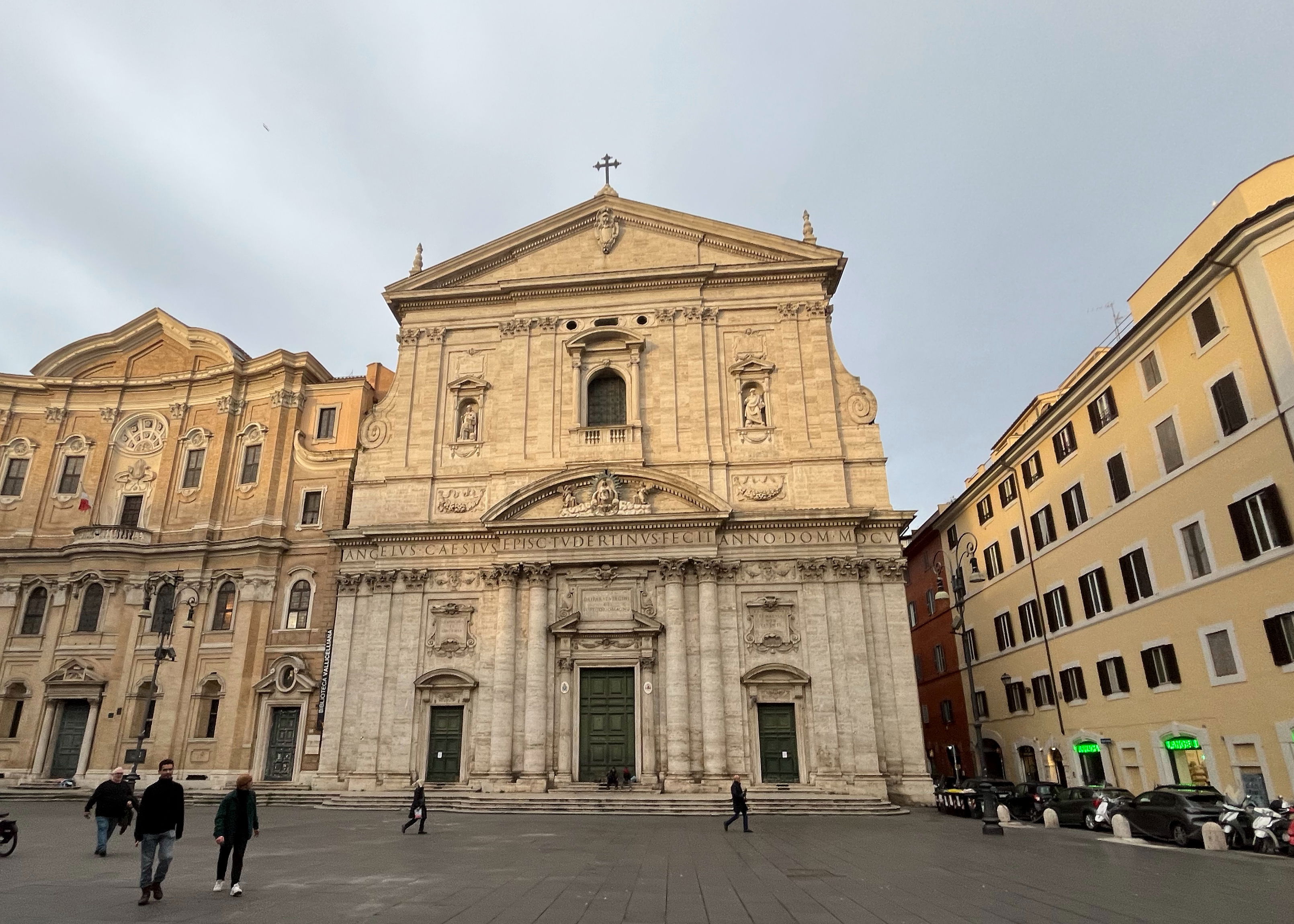
Santa. Maria in Vallicella, in piazza Chiesa Nuova
Next Heinz visited Santa. Maria in Vallicella, ("Our Lady in the Little Valley"). "with another terrific ceiling, and the Rubens altar piece with the angels holding up the picture of the Virgin". The church , faces onto the Corso Vittorio Emanuele and the corner of Via della Chiesa Nuova. It is the principal church of the Oratorians, a religious congregation of secular priests, founded by St Philip Neri in 1561 at a time in the 16th century when the Counter Reformation saw the emergence of a number of new religious organisations such as the Society of Jesus (Jesuits), the Theatines and the Barnabites. In 1575, Pope Gregory XIII recognised Neri's group as a religious Congregation and gave them the church and its small attached convent. St. Philip Neri, helped by Cardinal Pier Donato Cesi and Pope Gregory XIII, had the church rebuilt, starting in 1575. The church was consecrated in 1599. The facade, designed by Fausto Rughesi, was completed in 1605 or 1606.
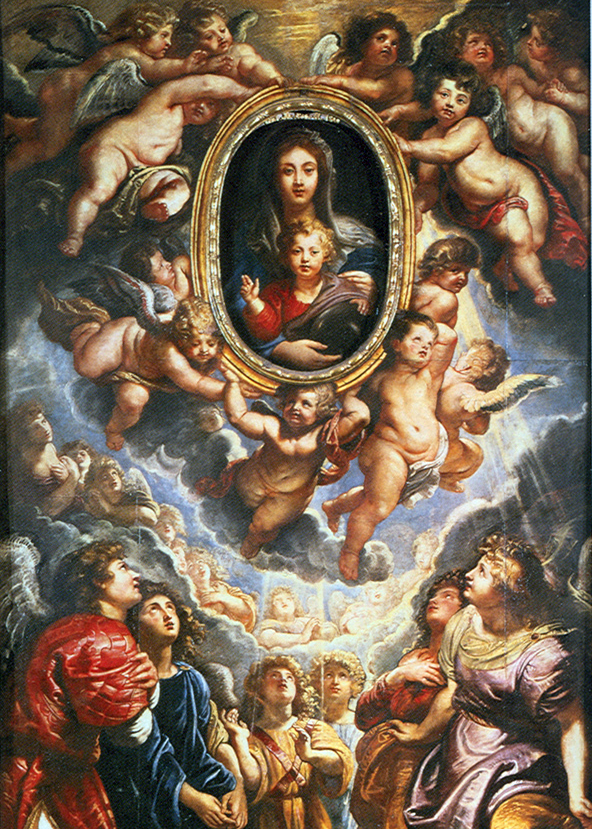
Rubens masterpiece in Santa. Maria in Vallicella,- unfortunately seemingly closed to the public
Peter-Paul Rubens was born in Siegen in Germany , his father, Jan Rubens, was a lawyer and alderman in Antwerp. His wife, Rubens' mother, Maria Pypelinckx, came from a prominent family originally from Kuringen, near Hasselt. The nobility in the Southern Netherlands at the time sided with the Reformation and Jan Rubens also converted to Calvinism. In 1566 the Iconoclasm raged, which was followed by a period of severe repression by the Catholic Spanish king Phillip II. In 1568, the Rubens family, with two boys and two girls, fled to Cologne because, as Calvinists, they feared persecution in their homeland during the harsh rule of the Duke of Alba, the Governor of the Habsburg Netherlands. Jan Rubens became the legal adviser of Anna of Saxony, the second wife of William I of Orange, and resided at her court in Siegen in 1570. He subsequently had an affair with her, which led to a pregnancy. Jan Rubens was imprisoned in Dillenburg Castle and was at risk of being sentenced to death for his offence. After his release, Jan Rubens was forbidden to practice his profession as a lawyer for some time and had to settle in Siegen under supervision. This put a heavy strain on the family, which was relieved only when in 1577, following the death of Anna of Saxony, the professional ban imposed against Jan Rubens was lifted. Into this difficult situation Philip Rubens was born in 1574, followed in 1577 by his brother Peter Paul who was baptised in Cologne at St Peter's Church. When in 1578 Jan Rubens was allowed to leave his place of exile Siegen, he moved the Rubens family moved to Cologne, where father Jan died in 1587.In Siegen, the family had belonged to the Lutheran Church. In Cologne, the family reverted to Catholicism. The eldest son, Jan Baptist, who may also have been an artist, left for Italy in 1586. The widow Maria Pypelinckx returned with the rest of the family including Peter Paul to Antwerp in 1590, where they moved into a house on the Kloosterstraat. Peter Paul received a humanist education in Cologne which they continued on their return to Antwerp, he studied at the Latin school in Antwerp, In 1590, he had to interrupt his schooling and go to work, in order to contribute financially to his sister Blandina's dowry. Subsequently, Peter Paul studied under two of the city's leading painters of the time, the Mannerist artists Adam van Noort and Otto van Veen. Much of his earliest training involved copying earlier artists' works, such as woodcuts by Hans Holbein the Younger and Marcantonio Raimondi's engravings after Raphael. Rubens completed his education in 1598, the year he entered the Guild of St. Luke as an independent master.
In 1600 Rubens travelled to Italy. He stopped first in Venice, where he saw paintings by Titian, Veronese, and Tintoretto, before settling in Mantua at the court of Duke Vincenzo I Gonzaga. The colouring and compositions of Veronese and Tintoretto influenced Rubens's painting, and his later, mature style was profoundly influenced by Titian. With financial support from the Duke, Rubens travelled to Rome by way of Florence in 1601. There, he studied classical Greek and Roman art and copied works of the Italian masters. The Hellenistic sculpture Laocoön and His Sons was especially influential on him, as was the art of Michelangelo, Raphael and Leonardo da Vinci, He was also influenced by the recent, Rubens later made a copy of Caravaggio's Entombment of Christ and recommended his patron, the Duke of Mantua, to buy The Death of the Virgin (Louvre).[14] After his return to Antwerp he was instrumental in the acquisition of The Madonna of the Rosary for the St. Paul's Church in Antwerp.[15] During this first stay in Rome, Rubens completed his first altarpiece commission, St. Helena with the True Cross for the Roman church of Santa Croce in Gerusalemme. Rubens travelled to Spain on a diplomatic mission in 1603, delivering gifts from the Gonzagas to the court of Philip III.[ While there, he studied the extensive collections of Raphael and Titian that had been collected by Philip II. He returned to Italy in 1604, where he remained for the next four years, first in Mantua and then in Genoa. From 1606 to 1608, he was mostly in Rome when he received, with the assistance of Cardinal Jacopo Serra the commission for the High Altar of the city's most fashionable new church, Santa Maria in Vallicella also known as the Chiesa Nuova. The subject was St. Gregory the Great and important local saints adoring an icon of the Virgin and Child. The first version, a single was immediately replaced by a second version on three slate panels that permits the actual miraculous holy image of the "Santa Maria in Vallicella" to be revealed on important feast days by a removable copper cover, also painted by the artist. His brother Philip was also at the time of his second residence in Rome as a scholar. The brothers lived together on Via della Croce near Piazza di Spagna. They had thus the opportunity to share their common interest in Classical art

7.Chiesa di Santa Susanna alle Terme di Diocleziano 8 Santa Maria della Vittoria

Chiesa di Santa Susanna alle Terme di Diocleziano
The next day Heinz visited Chiesa di Santa Susanna alle Terme di Diocleziano (The Church of Saint Susanna at the Baths of Diocletian) .Unfortunately this was also closed when tried to visit, still the outside was impressive. There had been a church on the site as since 280 CE, with the current church dating from 1585 to 1603, rebuilt for a monastery of Cistercian nuns . It was the last great rebuilding effort of Cardinal Girolamo Rusticucci, Cardinal protector of the Cistercian Order, A reflection of that action can be seen in a figurative program decorating the walls of the Church were to try and encourage a rebirth of the religious orders., with themes of chastity against corruption of morals and the victory of the true faith over any temptation to idolatry and heresy. They were joined by the exaltation of the virginal choice of St. Susanna and her prayerful attitude. Rusticucci wanted to highlight and connect these themes to the inseparable bond that his Church had with the Cistercian nuns whose monastery occupied the site. Rusticucci, gave the design of the architectural renovations Santa Susanna to Carlo Maderno (1556–1629) and he was responsible its travertine facade. The frescoes of the Central Hall (six scenes from the life of the chaste Susanna) are by Baldassare Croce of Bologna (1563-1638). the frescoes in the dome and apse curve with scenes from the life of the saint are attributed to Cesare Nebbia, a native of Orvieto (1536–1614).
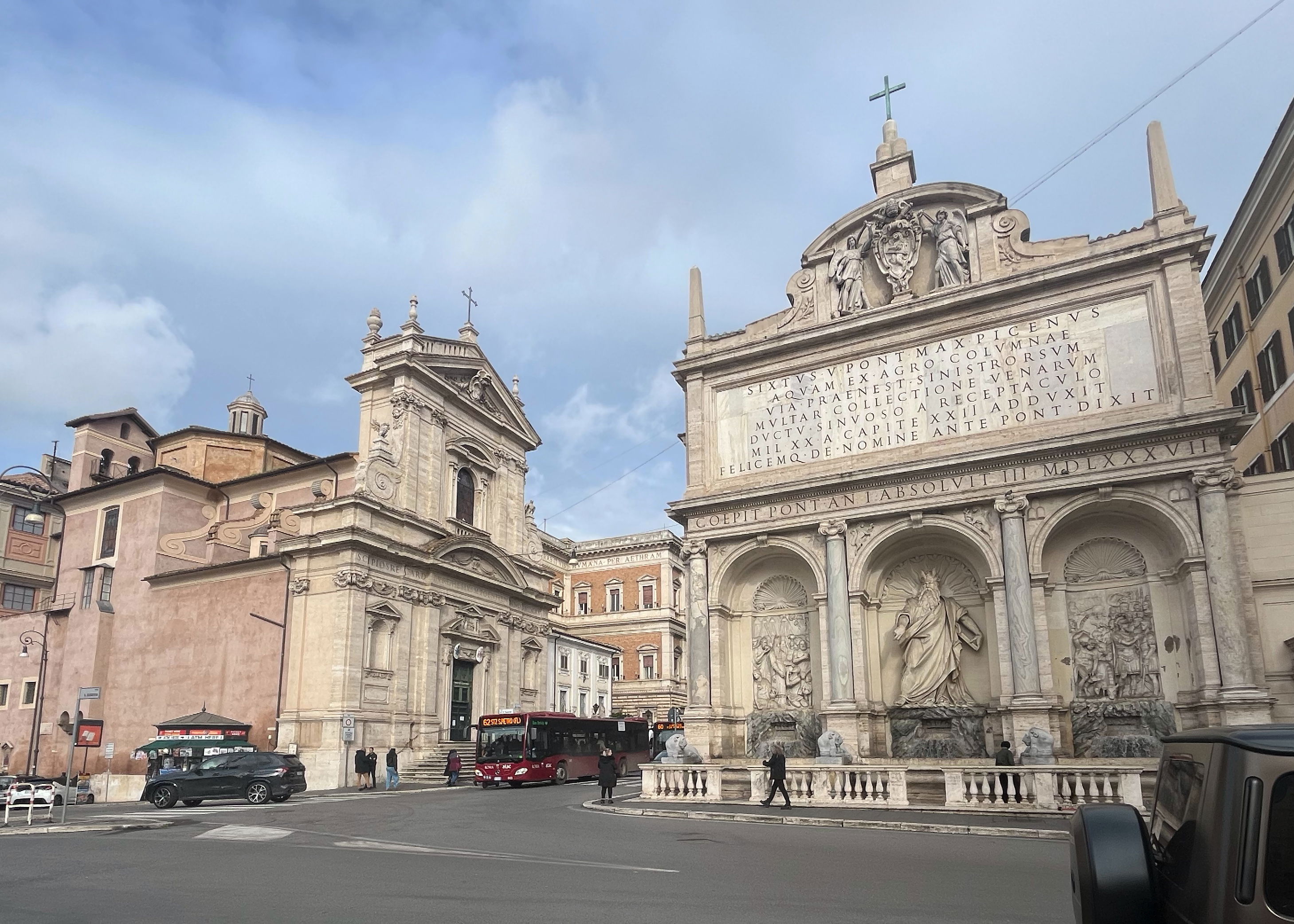

I had more luck with Heinz’s next destination , Santa Maria della Vittoria, , just over the road from Santa Susanna, so not far to go. The church is at number 98 via XX Settembre, where this street intersects with Largo Santa Susanna. It stands to the side of the Fontana dell'Acqua Felice. The church mirrors the Church of Santa Susanna across the Largo Regis) . Unfortunately for Heinz, the Bernini Ecstasy of St. Theresa had been walled in for protection, against the bombing the figures of the onlooking Cornaro family in the two side boxes were still visible.
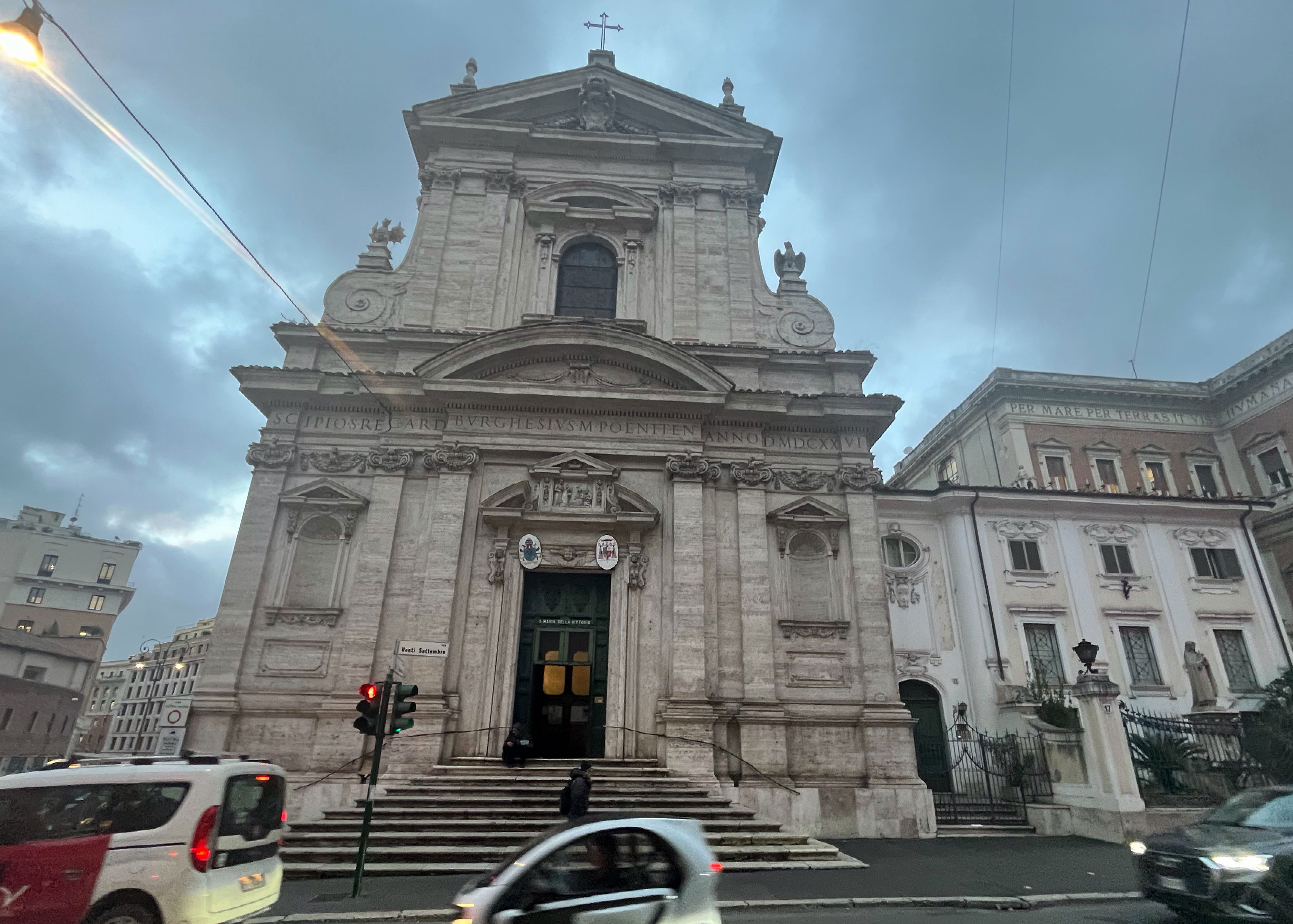
The church is known for the masterpiece of Gian Lorenzo Bernini in the Cornaro Chapel, the Ecstasy of Saint Teresa. The church is the only structure designed and completed by the early Baroque architect Carlo Maderno, though the interior suffered a fire in 1833 and required restoration. Its façade, however, was erected by Giovanni Battista Soria during Maderno's lifetime, 1624–1626, showing the unmistakable influence of Maderno's Santa Susanna nearby. Its interior has a single wide nave under a low segmental vault, with three interconnecting side chapels behind arches separated by colossal Corinthian pilasters with gilded capitals that support an enriched entablature. Contrasting marble revetments are enriched with white and gilded stucco angels and putti in full relief. The interior was sequentially enriched after Maderno's death; its vault was frescoed in 1675 with triumphant themes within shaped compartments with feigned frames: The Virgin Mary Triumphing over Heresy and Fall of the Rebel Angels executed by Giovanni Domenico Cerrini in 1675.
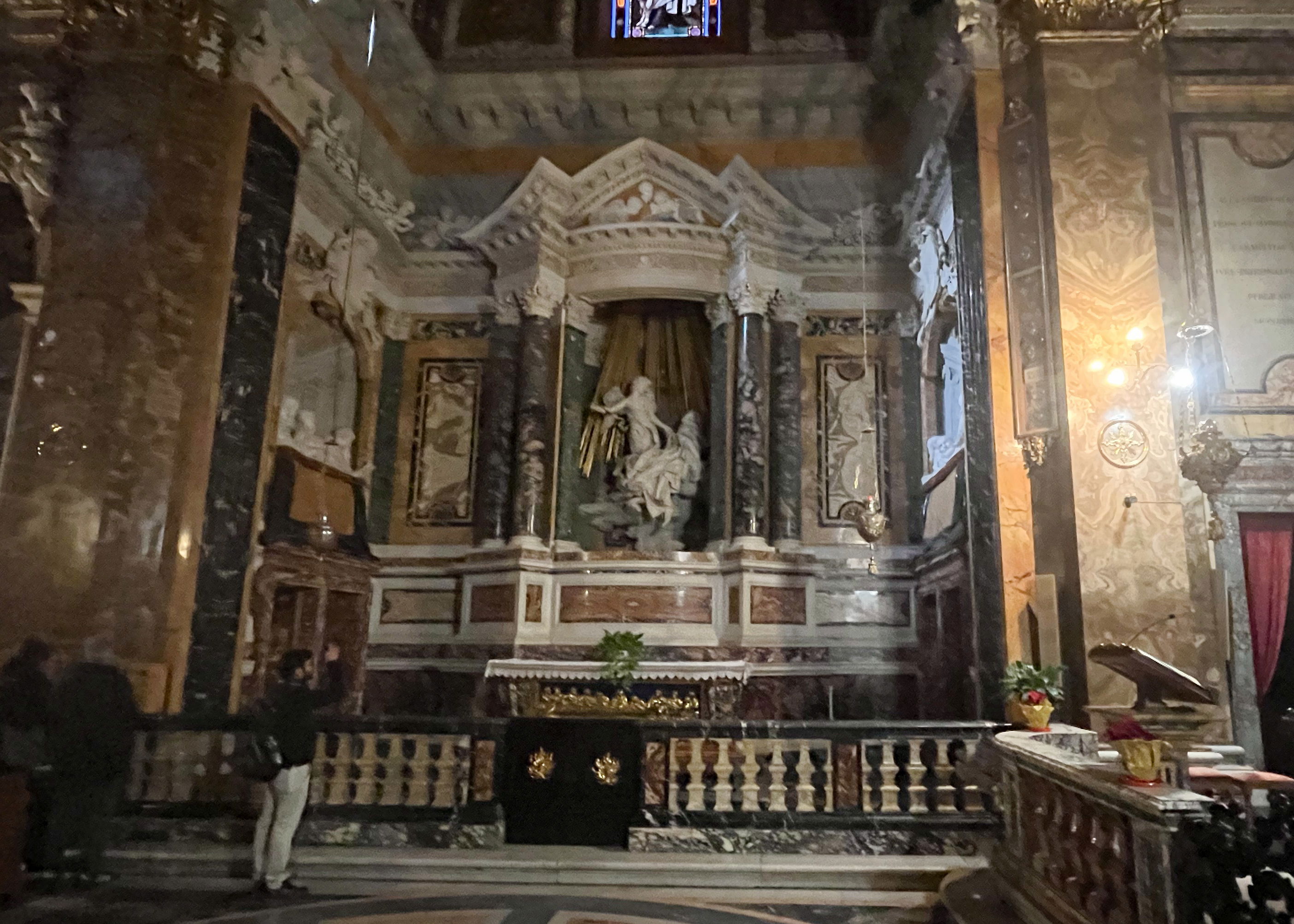
Bernini’s Ecstasy of St Theresa in the Cornaro Chapel,
Thannhauser was looking for Bernini’s Ecstasy of St Theresa in the Cornaro Chapel,. The statues depict a moment as described by Saint Theresa of Avila in her autobiography, where she had the vivid vision of a Seraph piercing her heart with a golden shaft, causing her both immense joy and pain. The flowing robes and contorted posture abandon classical restraint and repose to depict a more passionate, almost voluptuous trance. Although artistically a tour de force, nonetheless, during Bernini's lifetime and in the centuries following till this very day, Bernini's Saint Teresa has been accused of crossing a line of decency by sexualizing the visual depiction of the saint's experience, to a degree that no artist, before or after Bernini, dared to do: in depicting her at an impossibly young chronological age, as an idealized delicate beauty, in a semi-prostrate position with her mouth open and her legs splayed-apart, her wimple coming undone, with prominently displayed bare feet (Discalced Carmelites, for modesty, always wore sandals with heavy stockings) and with the seraph "undressing" her by (unnecessarily) parting her mantle to penetrate her heart with his arrow.
The entire ensemble was overseen and completed by Bernini during the Pamphilli papacy of Innocent X. When Innocent acceded to the papal throne, he shunned Bernini's artistic services; the sculptor had been the favourite artist of the previous and profligate Barberini pope, Urban VIII. Without papal patronage, the services of Bernini's studio were therefore available to a patron such as the Venetian Cardinal Federico Cornaro. Cornaro had chosen the hitherto unremarkable church of Santa Maria della Vittoria for his burial chapel. The selected site for the chapel was the left transept that had previously held an image of 'St. Paul in Ecstasy', which was replaced by Bernini's dramatization of the religious experience undergone by Saint Teresa of Avila who had been canonised not long before, in 1622.] It was completed in 1652 for the then princely sum of 12,000 scudi.
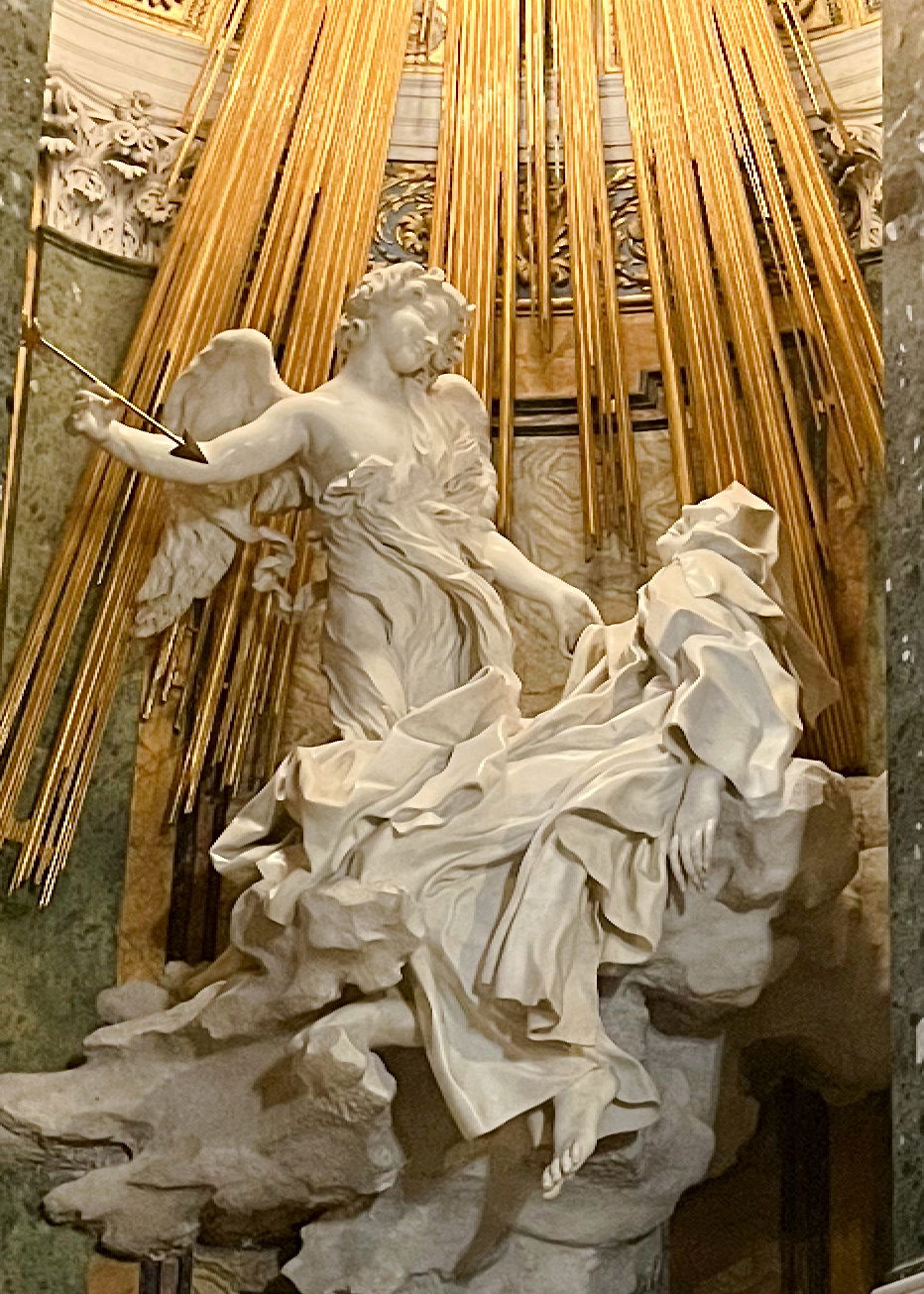
St Teresa of Avila ; "I saw in his hand a long spear of gold, and at the iron's point there seemed to be a little fire. He appeared to me to be thrusting it at times into my heart, and to pierce my very entrails"
The two central sculptural figures of the swooning nun and the angel with the spear derive from an episode described by Teresa of Avila in her autobiography, The Life of Teresa of Jesus .Her experience of religious ecstasy in her encounter with the angel is described as follows:
“I saw in his hand a long spear of gold, and at the iron's point there seemed to be a little fire. He appeared to me to be thrusting it at times into my heart, and to pierce my very entrails; when he drew it out, he seemed to draw them out also, and to leave me all on fire with a great love of God. The pain was so great, that it made me moan; and yet so surpassing was the sweetness of this excessive pain, that I could not wish to be rid of it. The soul is satisfied now with nothing less than God. The pain is not bodily, but spiritual, though the body has its share in it. It is a caressing of love so sweet which now takes place between the soul and God, that I pray God of His goodness to make him experience it who may think that I am lying.”
The group is illuminated by natural light which filters through a hidden window in the dome of the surrounding aedicule and underscored by gilded stucco rays. Teresa is shown lying on a cloud indicating that this is intended to be a divine apparition we are witnessing. Other witnesses appear on the side walls; life-size high-relief donor portraits of male members of the Cornaro family, e.g. Cardinal Federico Cornaro and Doge Giovanni I Cornaro, are present and shown discussing the event in boxes as if at the theatre. Although the figures are executed in white marble, the aedicule, wall panels and theatre boxes are made from coloured marbles. Above, the vault of the Chapel is frescoed with an illusionistic cherub-filled sky with the descending light of the Holy Ghost allegorized as a dove. illusionistic cherub-filled sky with the descending light of the Holy Ghost allegorized as a dove.
The art historian Rudolf Wittkower wrote:
“In spite of the pictorial character of the design as a whole, Bernini differentiated between various degrees of reality, the members of the Cornaro Chapel seem to be alive like ourselves. They belong to our space and our world. The supernatural event of Teresa's vision is raised to a sphere of its own, removed from that of the beholder mainly by virtue of the isolating canopy and the heavenly light”.

The Cornaro Family survey the scene from a theatrical box
The effects are theatrical, the Cornaro family apparently the scene from their boxes, and the chapel illustrates a moment where divinity intrudes on an earthly body. As Bernini biographer Franco Mormando points out, although Bernini's point of departure for his depiction of Teresa's mystical experience was her own description, there were many details about the experience that she never specifies (e.g., the position of her body) and that Bernini simply supplied from his own artistic imagination, all with an aim of increasing the nearly transgressively sensual charge of the episode: "Certainly no other artist, in rendering the scene, before or after Bernini, dared as much in transforming the saint's appearance." The sexual implications of the work have not gone unnoticed. Bernini has been accused of "turning a private moment into a public spectacle; offering Teresa's rapture up for eroticized observation." Mouth agape, body spent, the saint is not only in orgasm, she is overwhelmingly and classically beautiful.
The Victorian art critic Anna Jameson, in her 1850 Legends of the Monastic Orders, seems to singles out Bernini among the 17th-century artists who all represent her with too much worldly “materialism,” a style of which in her words was ;
,"the grossest example—the most offensive—is the marble group of Bernini, in the Santa Maria della Vittoria at Rome. The head of St. Theresa is that of a languishing nymph; the angel is a sort of Eros; the whole has been significantly described as a “parody of Divine love.” The vehicle, white marble;—its place in a Christian church—enhance all its vileness. The least destructive, the least prudish in matters of art, would here willingly throw the first stone."
In discussing the Ecstasy of St. Teresa, Burckhardt stresses the erotic dimension in more explicit terms than Jameson, but his disgust is not dissimilar to hers:
"In a hysterical fainting fit, her gaze broken, lying on a mass of clouds, the saint has flung back her arms and legs, while a lustful angel aims at her with the arrow (that is, the symbol of divine love). In this case, one frankly forgets all questions of mere style because of the outrageous degradation of the spiritual element "
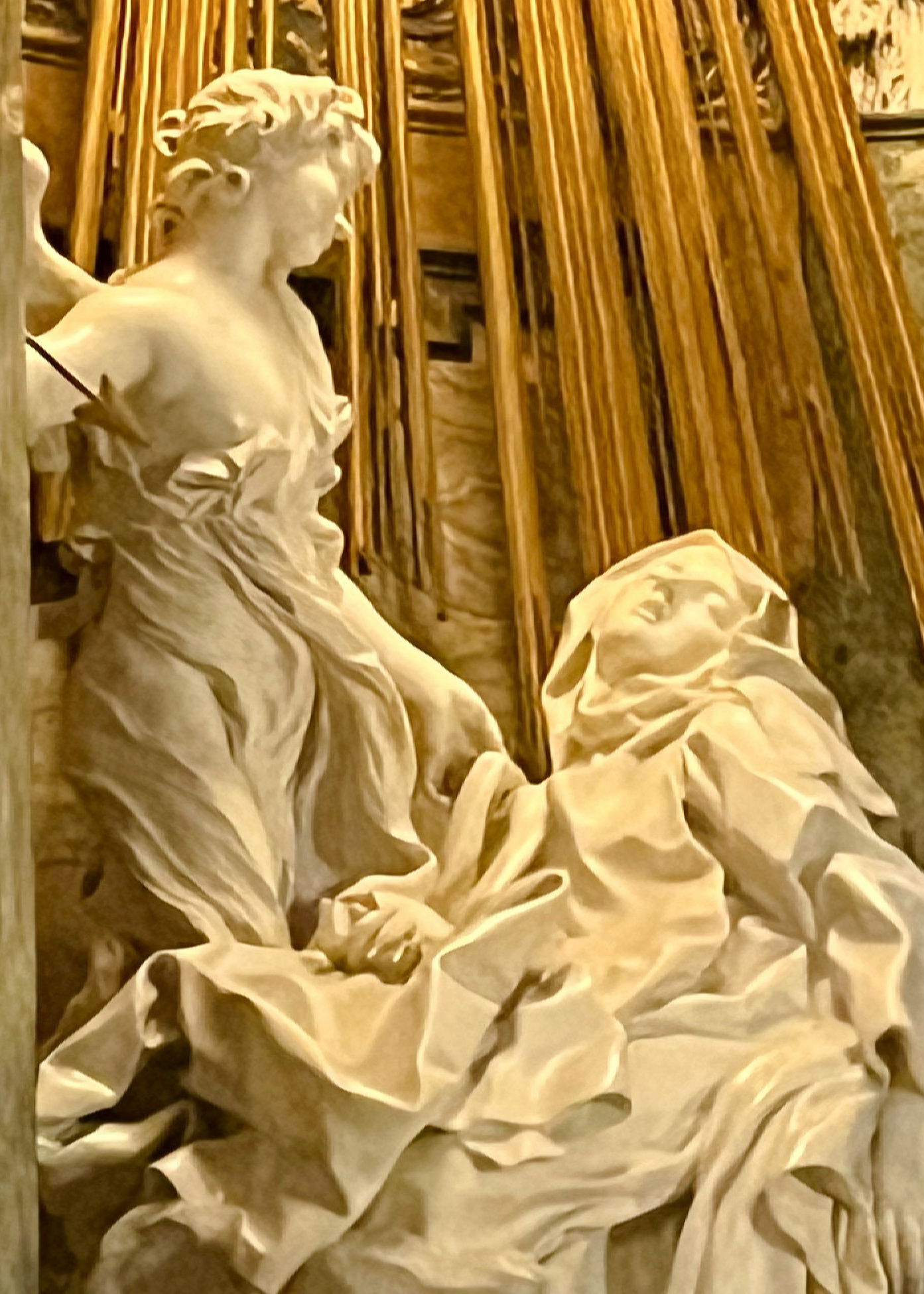
The head of St. Theresa is that of a languishing nymph; the angel is a sort of Eros; the whole has been significantly described as a “parody of Divine love
Historian Franco Mormando argues that the reason for the popularity of Bernini’s Teresa is not merely artistic or religious, but also has a lot to do with sex. The statue provokes wonder, if not o shock, about this blatant melding of the spiritual and sexual, within a Catholic church in Rome during the supposedly morally vigilant times of the Counter-Reformation."Although some art historians insist that Bernini could not possibly have meant to imply eroticism, the sexual implications of the work are unmistakable: a beautiful, bare-chested young angel opens Theresa's dress, preparing to penetrate her with his arrow, while the saint throws back her head in ecstasy. Bernini's rebuffed his critics with the retort: “‘Better a poor Catholic than a good heretic,’ Pope Urban VIII criticism of Bernini, he believed that Bernini was “a rare man, of sublime talent, born by divine disposition . . . to bring light to this age.”

The Ecstasy of St Theresa

9. San Carlo alle Quattro Fontane, 10. Santa Maria Maggiore 11.Basilica di San Clemente al Laterano.
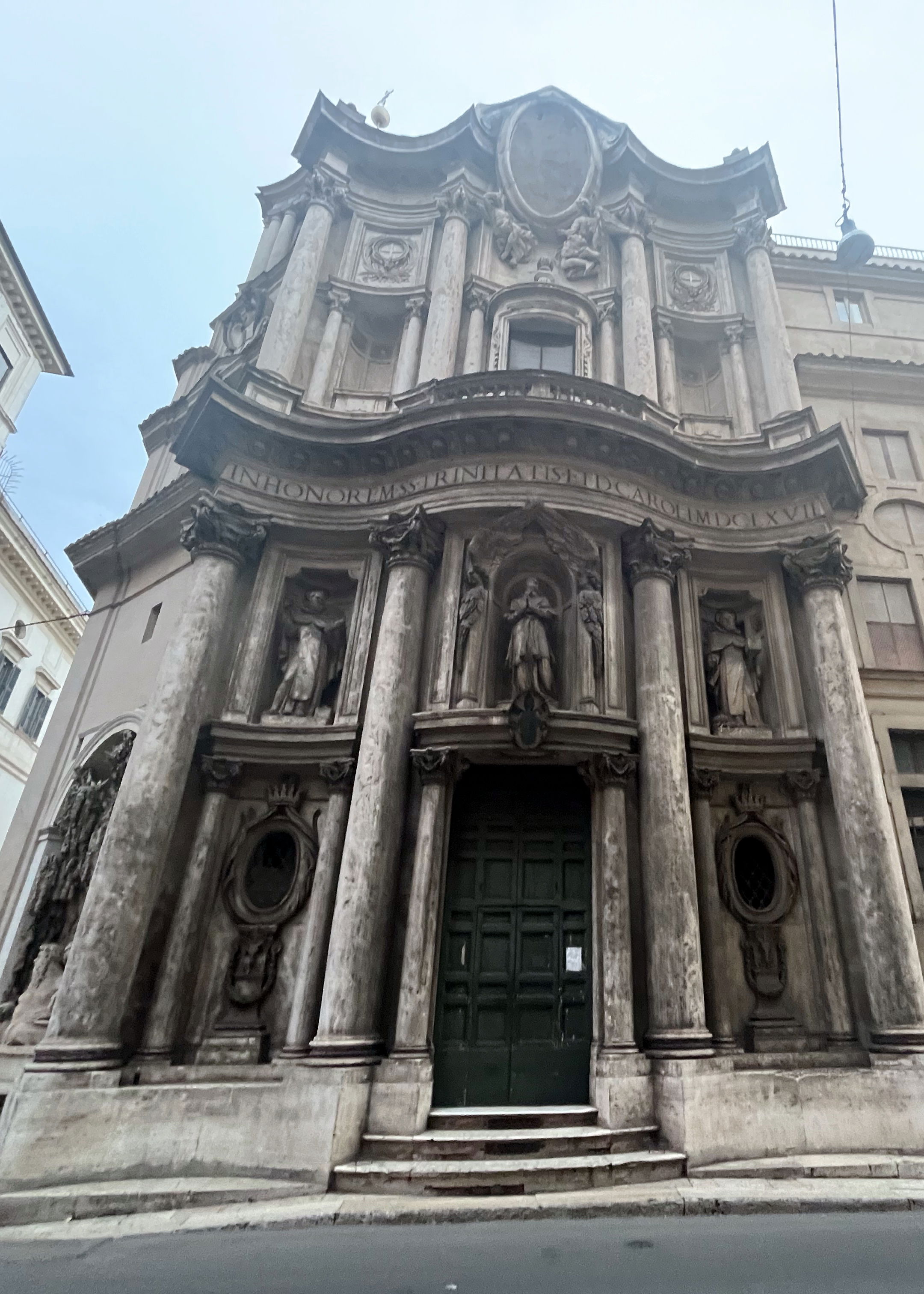
San Carlo alle Quattro Fontane,
Next it was on to San Carlo alle Quattro Fontane, which Heinz described as “From there the tour continued the short distance to The church of San Carlo alle Quattro Fontane (Saint Charles at the Four Fountains), also called San Carlino",., which he described as “Borromini’s tours de force”. This was also closed , but the outside was worth a look. The church was designed by Francesco Borromini and was his first independent commission. It is regarded as a masterpiece of the Baroque architecture and was built as part of a complex of monastic buildings on the Quirinal Hill for the Spanish Trinitarians, an order dedicated to the freeing of Christian slaves.. Francesco Borromini offered to complete the commission for free to kickstart his career as a solo architect. The is at the southwest corner of the "Quattro Fontane", which refers to the four corner fountains set on the oblique at the intersection of two roads, the Strada Pia and the Strada Felice. The monastic buildings and the cloister were completed first, after which construction of the church took place during the period 1638–1641; in 1646 it was dedicated to Saint Charles Borromeo. Although the idea for the serpentine facade must have been conceived fairly early on, probably in the mid-1630s, it was only constructed towards the end of Borromini's life and the upper part was not completed until after the architect's death. Borromini from a lower-class background but quickly built a name for himself by taking on small commissions for churches around Europe. He first found his interest in architecture through his travels to Milan, in which his father sent him to observe stonecutting. His interest lead to years of architectural and sculptural training which caused a growing debt to his father. He then fled to Rome to avoid his debt and found himself becoming an architectural star pupil under renowned Italian architect Carlo Maderno. Together, Maderno and Borromini worked side by side on s, St. Peter's Basilica, Palazzo Barberini, Sant ’Andrea della Valle, until Maderno died and Borromini found himself working as a solo architect.
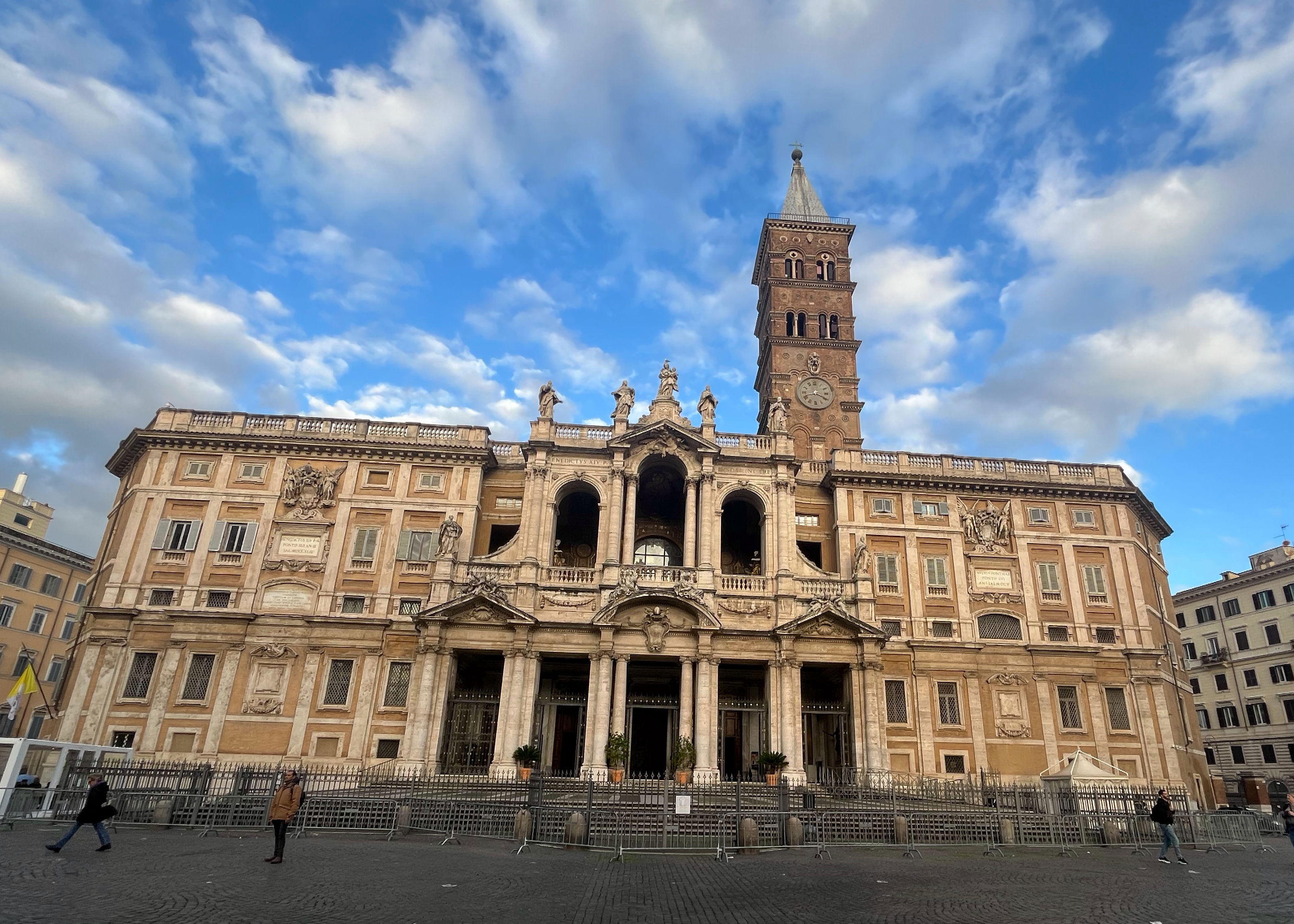
Santa Maria Maggiore.
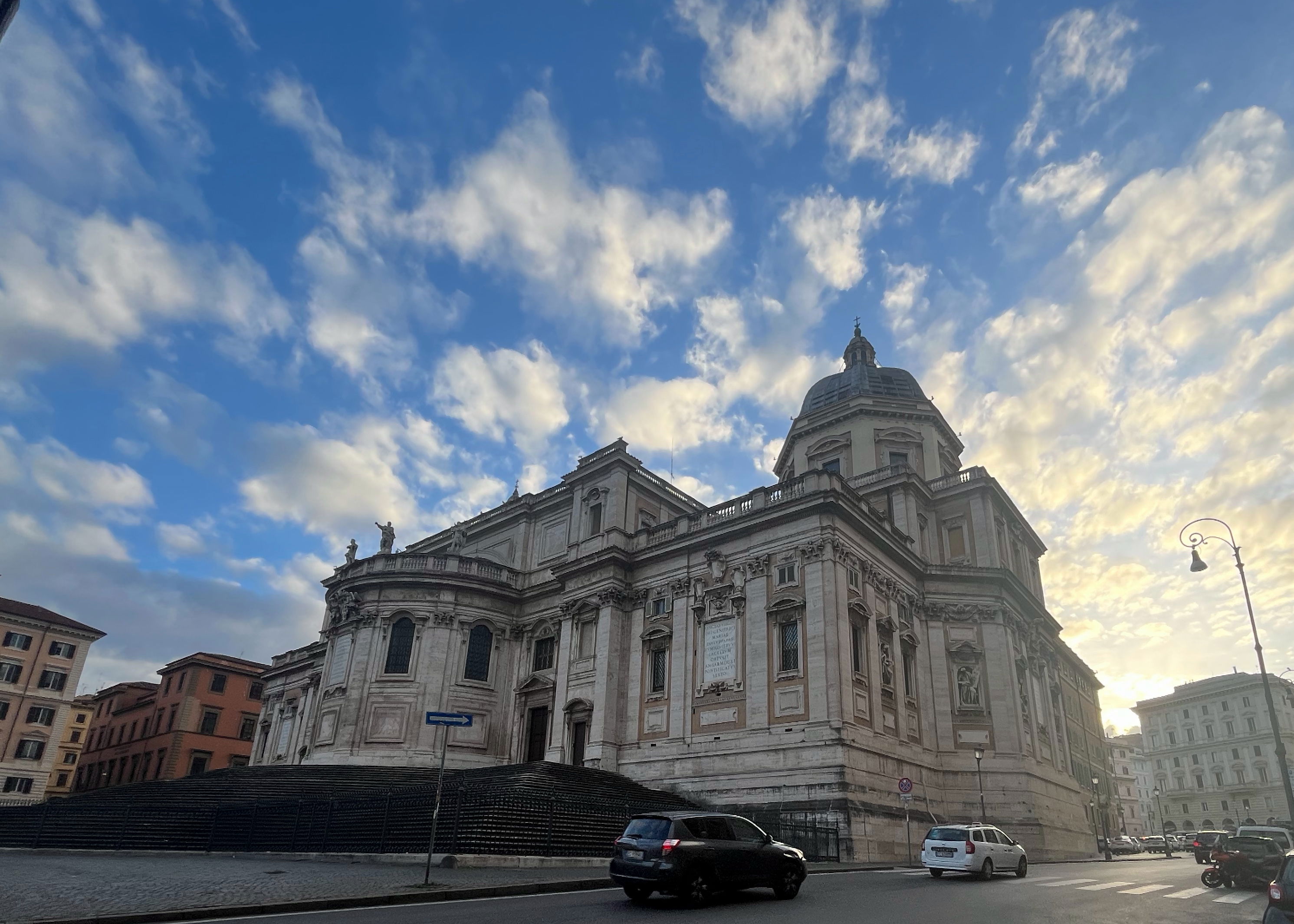
Santa Maria Maggiore.
From there Heinz continued to Santa Maria Maggiore. This reminded Heinz of a paper he had written for Koehler for his Master’s at Harvard:
“…that unending paper I wrote for Koehler on the mosaics there. I was afraid they’d probably have them walled up like most of the apsidial mosaics in Rome, but lo and behold, they were all there in their full freshness! It was one of the most terrific artistic impressions I got on our stay in Rome. I had not expected anything like the strength of color that remains just gleaming out at you, – especially so, of course, in the case of the Torriti work but amazingly bright too with the old mosaics. We walked round the whole church looking at the mall: the walls of Jericho falling down, God’s hand throwing stones down on the enemy, Lot’s wife turning to salt, the passage over the Red Sea, etc. I really was happy we had been able to get into Sta. Maria Maggiore. “
The Koehler , Heinz is referring to was Wilhelm Koehler under whom he had studied under at Harvard. Renowned Medievalist and professor of art at Harvard. Köhler was born in Reval, ( now Tallin) in Estonia. Having attended a Gymnasium in Wolfenbüttel, between 1903-1907 he studied art history in Strassburg, Bonn, and finally Vienna. His dissertation in 1906 was written under the so-called “first” Vienna-school of art historians Franz Wickhoff and Max Dvořák. Dvorak was a pioneer, the first art historian to establish Geistesgeschichte as a branch of study in his discipline. The term is largely untranslatable, sometimes translated as "intellectual history" or "history of ideas",. The branch of study it denotes is often seen as having been inspired by the type of work done by Wilhelm Dilthey and his followers. The term derives from the German Geist, "spirit" or "mind" [here connoting the metaphysical realm, in contradistinction to the material], and Geschichte, "history, It is concept in the history of ideas denoting the branch of study concerned with the undercurrents of cultural manifestations, within the history of a people, that are peculiar to a specific timeframe. Inspired by Dilthey's historical approach to the theory of Weltanschauung, Max Dvorak (author of fundamental studies on the arts of early Christianity, the Middle Ages, the VanEyck brothers, and Mannerism.) assumed a strict continuity in the evolutionary processes, from the Middle Ages to Impressionism. Dvorak interpreted the visual arts as the expression and spiritual manifestation of a unified totality of thought underlying all aspects of cultural and other human phenomena. His interpretation of art history as Geistesgeschichte is apparent in his major work, Idealism and Naturalism in Gothic Art, In this study, Dvorak deals with medieval art generally and Gothic sculpture and painting specifically. Proceeding ingeniously from analogies he draws between the visual arts and other contemporary phenomena; he finds the basis of the arts in a Weltanschauung of medieval Christianity. Rather than explain the arts as causally determined by events in the development of new economic, social, or religious thought, and believing that the spiritual qualities of medieval art cannot be extrapolated from the writings of the great theologians of the period, he finds parallel-isms between the visual arts and these other phenomena. For instance, medieval art and medieval philosophy are not caused by each other but are the product of the total framework of the prevailing global outlook. For Dvorak, medieval art both derived from and reflects this prevailing outlook. By the end of his life Dvora had perceived three revolutionary breaks in the continuity of Western art: early Christianity, Mannerism, and Expressionism and Surrealism.
The following year Koehler began a project of publishing illuminated manuscripts organized by school, Die karolingischen Miniaturen, for the Deutsche Verein für Kunstwissenschaft. The scope of the task was such that the first did not appear until 1930-1933 and the second volume twenty-five years later. He served in the military in World War I in Poland and later researching in Belgium. After the war he was offered a position as director of the new art collection in Weimar (Staatlichen Kunstammlungen). He developed contacts with many Bauhaus faculty including Paul Klee and Lyonel Feininger. The product of his war years research on Carolingian art appeared in 1923 as Belgische Kunstdenkmäler. From 1924 he also held a professorship at Jena University. The first volumes of his Carolingian manuscript study, Die Schule von Tours appeared between 1930-1933. Meanwhile his association with modern art brought him into increasing conflict with the Nazi government. So Köhler left Germany and arrived at Harvard in 1932 as the Kuno Franke Visiting Professor of German Art and Culture. He did not go back, when Harvard’s well-known medievalist A. Kingsley Porter died in a drowning accident the following year, he became Professor of Art History,

Jacopo Torriti's mosaic "The Coronation of the Virgin" in Santa Maria Maggiore
The apse is decorated with a mosaic by Jacopo Torriti depicting the Coronation of the Virgin . Although common North of the Alps, Torriti’ s mosaic is believed to be its fist occurrence in Italy and very splendid it is too, The main image is the coronation of the Virgin , beneath it are five further scenes from the Life of the Virgin Mary the Annunciation; , the Nativity, the Adoration of the Kings , the Presentation in the temple and the Dormition. The Dormition , which was the Eastern Church equivalent of the Western Church’s assumption. Dormition, - literally means “ the fallen asleep” – signifying that the death of Mary was in a state of spiritual peace. The Catholic Assumption which gradually took over in the West , covered Mary’s movement towards heaven. It had to wait until 1997, when Pope John Paul II confirmed that Mary had experienced a natural death before her assumption into heaven, So glad we got that sorted out.
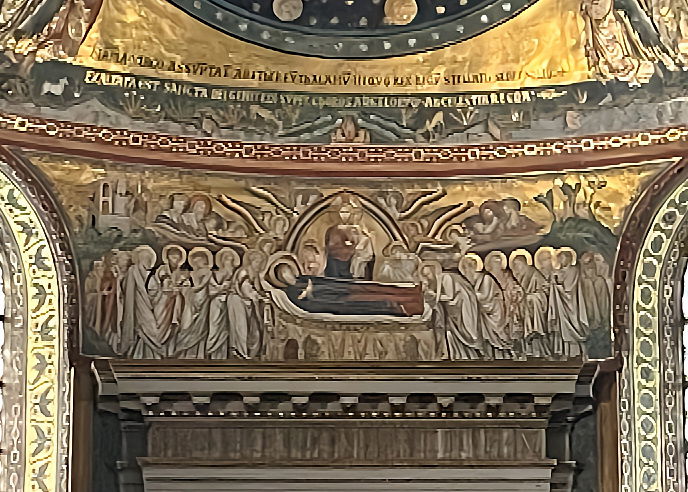
A detail of the Dormition - the Eastern version of the Assumption
Unfortunately not much is known about Torriti . but he may also have executed mosaics in the San Giovanni Lateran in Rome and in Assisi ,On the left side of the Coronation are Pope Nicholas IV , kneeling , St Peter , St Paul and St. Francesco , with his tonsure. Pope Nicolas IV has commissioned the mosaic, so it is not surprising he is shown. . And on the other side, in the donor position is Cardinal Giacomo Colonna , then St John the Baptist, St James the Great and St Thomas. The apse of Santa Maria is the most important survivor of Roman mosaic art from the Middle Ages, given its proximity to the heavily bombed Termini station, it is lucky to have survived.
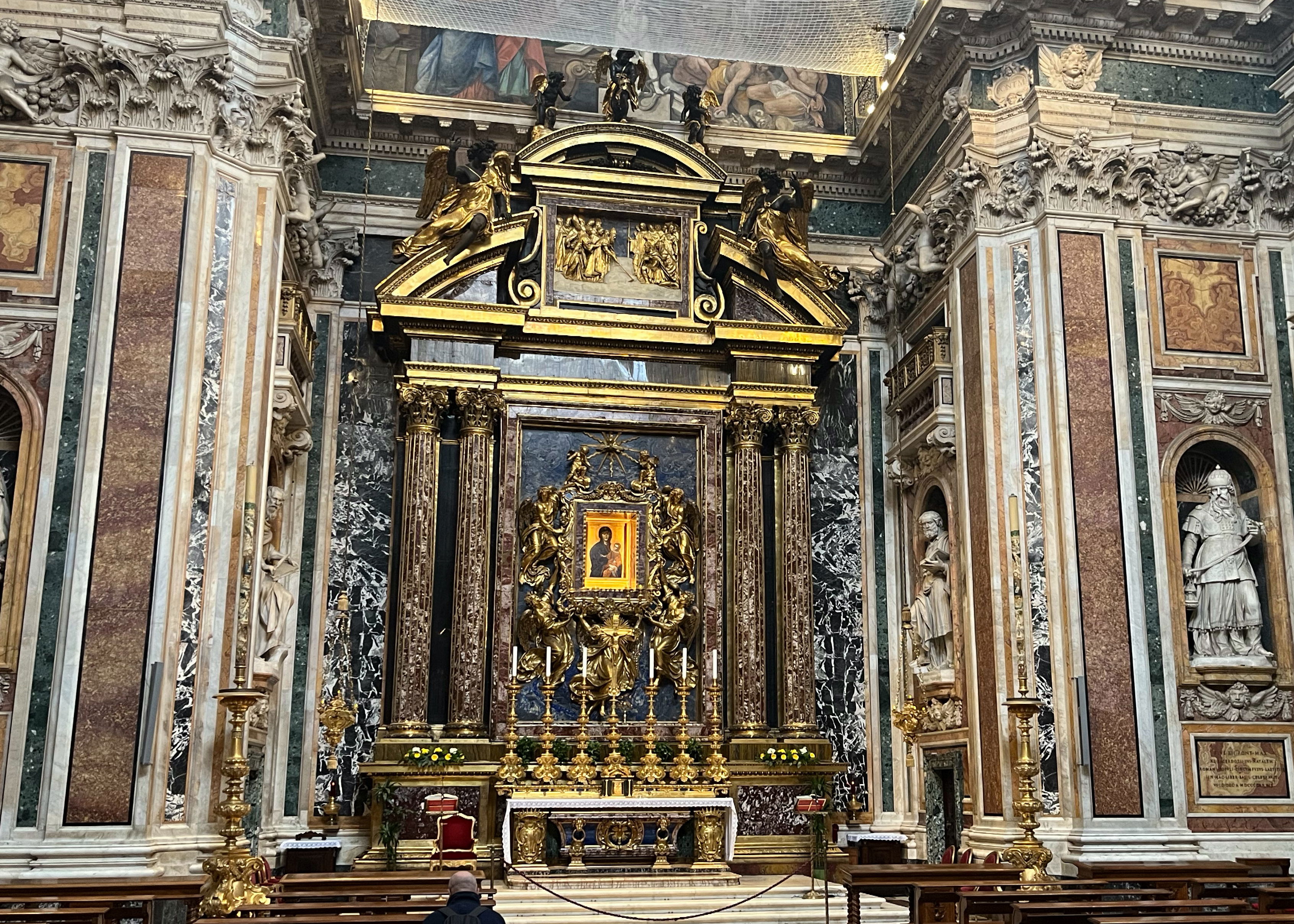
The icon of the Salus Populi Romani at Santa Maria Maggiore
The basilica also enshrines the venerated image of Salus Populi Romani, depicting the Blessed Virgin Mary as the health and protectress of the Roman people, the painting is reputed to be by Luke the Evangelist and supposedly arrived in Rome from Crete in 590 CE , during the pontificate of St Gregory the Great, who welcomed the icon o Rome. Art historians have dated te icon anywhere between the fifth century and the thirteenth, which is not particularly helpful. It seems to have been overpainted several times , definitely the style can be dated to the 8th century , with its similarity to Eastern icons of the same period. .According to legend which was granted a Canonical coronation by Pope Gregory XVI on 15 August 1838 accompanied by his Papal bull Cælestis Regina.

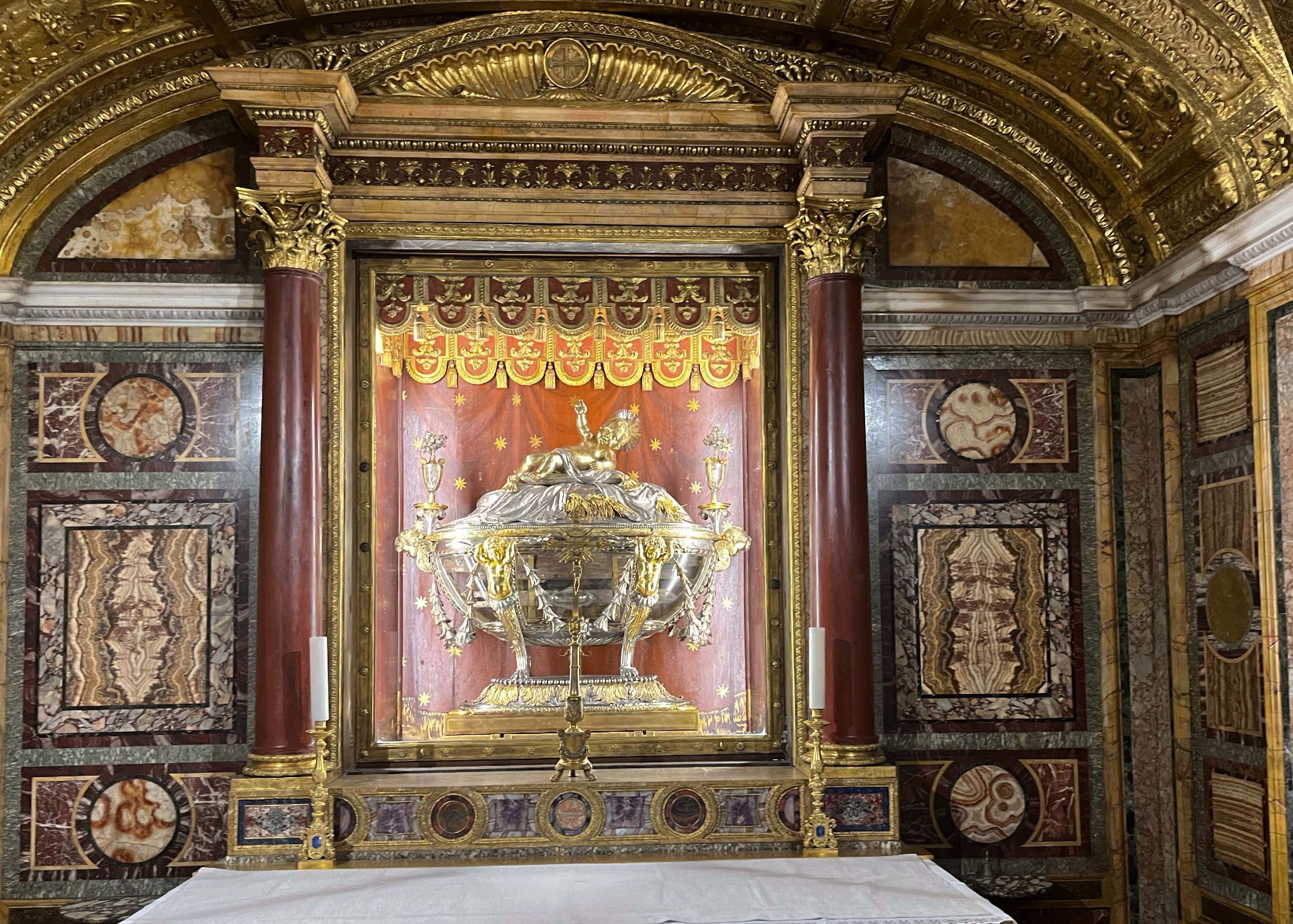
The reliquary of the Holy Crib at Santa Maria Maggiore
The final surprise in Santa Maria , is the reliquary containing pieces of the Holy Crib. In 432, Pope Sixtus III crested within the basilica, a “ cave of the nativity “ similar to Bethlehem. Pilgrims returning from the Holy Land, bought with them more pieced of the "Holy Crib” and they were incorporated into the reliquary, which subsequently got its own location. The chap knneling in prayer is Pope Pius IX and was put there in the 19th Century.
Following the Lateran Treaty of 1929 between the Holy See and Italy, the Basilica is within Italian territory and not the territory of the Vatican City State. However, the Holy See fully owns the Basilica, and Italy is legally obligated to recognize its full ownership and to concede to it "the immunity granted by International Law to the headquarters of the diplomatic agents of foreign States. In other words, the complex of buildings has a status somewhat similar to a foreign embassy.

The Basilica di San Clemente al Laterano.
From Santa Maria Maggiore , he continued towards the centre of Rome ,the Basilica di San Clemente al Laterano. San Clemente, is about 200 or 300 m from the Colosseum, Thannhauser has specifically gone to see Masaccio’s chapel. An Irish priest Father McSweeney took them around, “The mosaics were covered over, but we had plenty of time to study all the details of the Masaccio and Masolino works, and then went down to the old church below, with the Mithraic statue and the other amazing things. for Heinz "Father McSweeney’s delightful and enlightened descriptions made this one of most memorable visits in Rome.”
The present basilica dedicated to Pope Clement I was bult in the 1100s. It is a three-tiered complex of buildings. In 1857, Father Joseph Dooley , began excavations under the present basilica and uncovered two further levels The remains of the 4th-century basilica and the home of the Roman nobleman had been built on the foundations of republican era villa and warehouse that had been destroyed in the Great Fire of AD 64. The first century Roman structure , was separate from the Mithraeum, bult by an early Roman cult. When Christianity became the official religion of the Roman Empire. Pagan sects including the cult of Mithras were declared illegal. The Mithraeum was acquired by the clergy of San Clemente who then built the original basilica on top.

And why was a priest called Father McSweeney on the scene? Well as mentioned , San Clemente was under the ownership of the Irish Dominicans The basilica had been given to the Irish Dominican order in 1677, when Irish clergy had been banished from Ireland under British rule. The Irish Free State had remained neutral during the war and Irish church buildings in Rome remained under the protection of the Irish Legation in Rome. Even after the Armistice and the German occupation, the Legation remained in Rome , continuing to recognise the Italian Royal Government., even though it was no longer present in the city. Encroachments into Irish religious property by the Germans were usually rebuffed by the showing of a protection letter in German, Italian and English. Although the Irish Government remained rigidly neutral, individual Irish clergy had taken considerable risks in hiding escaped allied prisoners and others persecuted by the regime. Perhaps the story of Hugh O’Flaherty, “the Vatican Pimpernel” is the best known. The story of the Irish in Rome during the war is interestingly told in a recent book “Roman Imbroglio”.by Isadore Ryan.
During the German occupation, the Prior of San Clemente was Raymond Dowdall ( he may also have called himself O’ Dowdall to emphasise that he was not English ) . Dowdall was a native of Newry, who had arrived in Rome in 1921 to study at the Angelicum College and been there ever since. Due to the difficulties of new clergy getting through occupied Europe, by 1942, there were only five Dominicans left at San Clemente, including Aengus Buckley, Hugh Marquess, Simon McAuliffe and Peter McSweeney. It was presumably Peter McSweeney who emerged to show Heinz around San Clemente, A native of Cork, he had been at San Clemente since 1929. During the war, the basilica had provided a water supply to local residents after Allied bombing knocked out the mains water supply. Around 20 families camped out in the gardens to stay safe from the bombing. At night they would head down to the excavated underground levels of the basilica to stay safe. These subsequently also became an official air-raid shelter. As well it vegetable gardens, the basilica also acquired a couple of cows, which provided free fresh milk to the local people, Although supplies were shirt, the Dominicans were able to get some supplies through the Vatican and helped out some of the local community who were living in dire conditions in local caves.
After the Germans occupied Rome, Dowdall and the Dominican brother had sheltered a variety of individuals who were wanted by the Italian authorities It has been said that they allowed Rome’s Jewish community to worship in the church, but Dowdall does not mention this in his own memoir of the time. The brothers did , however, shelter a couple of notable fugitives at the basilica. Conte Luigi Vidau was a former high functionary of the Italian Foreign Affairs Ministry who following his role after the fall of Mussolini, was now wanted by both the Fascists of the Italian Social Republic and by the Germans. Generale Fernando Solet was a former Police chief , who had also bee involved in the overthrow of Mussolini. He had been arrested by the Germans and used as a human shield during the daring raid to rescue Mussolini at Gran Sasso. Subsequently, Soleti had been taken to Munich from where he escaped and made his way back to Rome. He was then hidden in the Basilica for around three months until a more stable hiding place could be found.
Even after the Americans occupied Rome, life continue to be difficult for the Dominican brothers, with ongoing food shortages, and continuing discomfort as the war moved northward; however, they and the basilica of San Clemente and its valuable artworks had made it through the war mostly unscathed.

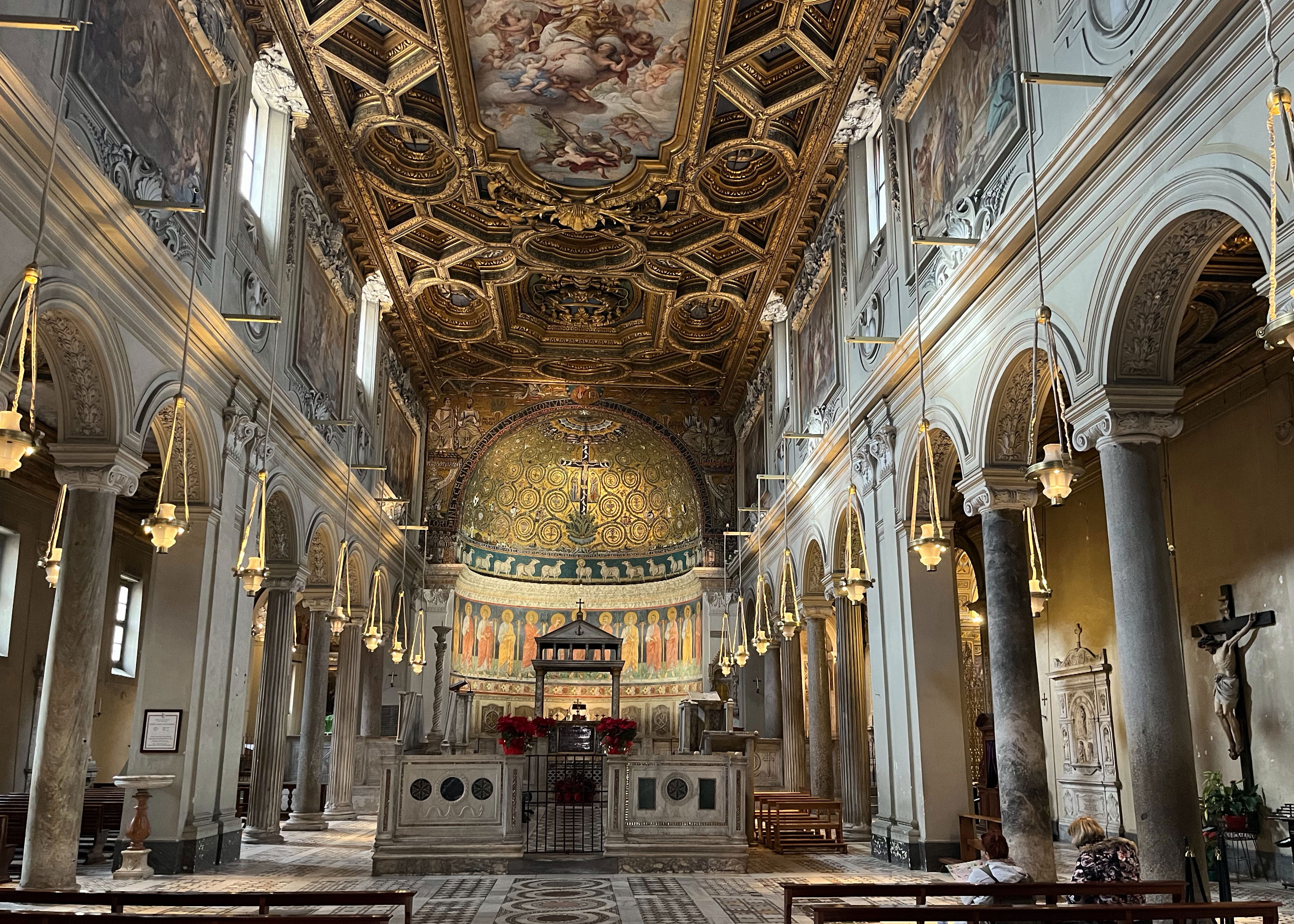

The Crucifixion in the Capella Castiglione
The frescoes in the Chapel of St Catherine also known as the Capella Castiglione , are attributed to Masolino da Panicale , but may have been started by the young Florentine painter Masaccio. Branda da Castiglione, a carinal and head of the Basilica of San Clemente commissioned Masolino , a Tuscan artist who had been responsible for the Branccaci Chapel frescoes in Florence . Masaccio a contemporary Florentine artist had also worked on the Brancaccio Chapel. Giorgio Vasari originally attributed the Chapel to Masaccio but was apparently confused about dates. The frescoes were subsequently attributed to Masolino. Since nobody knows for sure, the compromise might be that Masaccio started them, and after his death in 1428 , Masolino continued. A gifted art historian like Thannhauser would undoubtedly have been aware of this.
Over the entrance to the chapel on the outside is represented the Annunciation ; with the Virgin Mary at prayer receiving an he angel's salutation. Under the arch are painted the twelve Apostles. On the wall behind the altar is the Crucifixion. The peaceful landscape in the background in contrast with the violent scenes being played out in the foreground, . On the left of Jesus a demon seems to be violently dragging away the soul of the thief, while on the right an angel receives the soul of the repentant thief. Mary Magdalene stands weeping with the Beloved Disciple ( St John the Evangelist). A sword has pierced the heart of the Virgin-Mother ( to signify suffering) , and she faints into the arms of the women supporting her. On the wall to the left is depicted the martyrdom of St. Catherine.
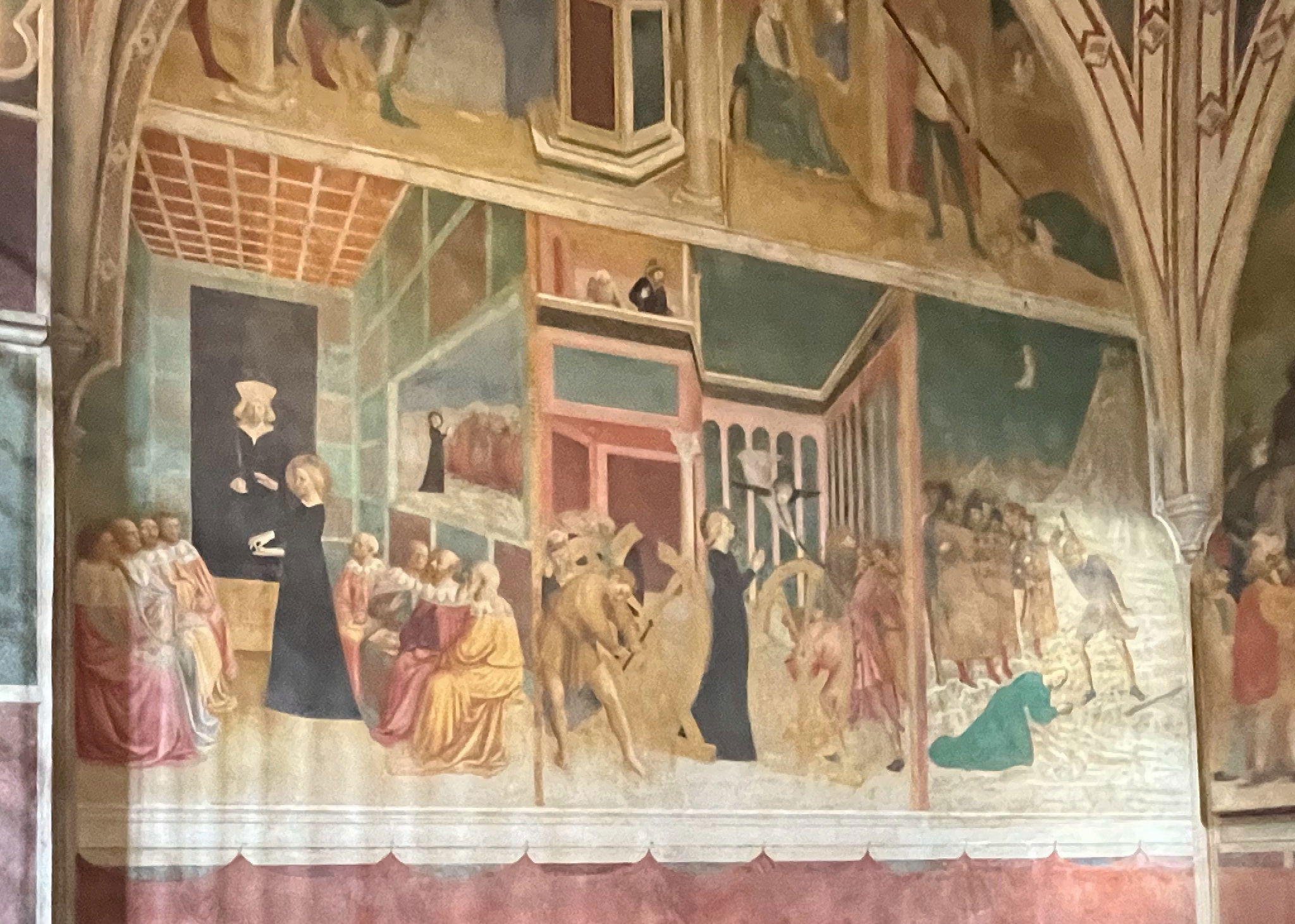
Detail from the Fresco of St Catherine. From left to right. St Catherine disputing with the doctors. The wheel being broken and the beheading of St Catherine.
The Saint in the presence of the Emperor disputes with the learned Doctors of Alexandria on the Mysteries of Religion. She converts them, and the consequence of their conversion is seen in the fiery death to which they are doomed.. Higher up on the wall she is seen reproving the idolaters ; then in another scene she is conversing from her prison window with the Empress whom she also converts. The enraged Emperor condemns St Catherine to be tortured on the wheel, but an angel appears and breaks that engine, the fragments of which injure the executioners while Catherine escapes unhurt. Finally we see her kneeling with her neck bared while the axe in the executioner's hand is raised to deal the deathblow The subjects on the opposite side have been detached from the wall, put on canvas and replaced, in order to preserve them from the damp which had al-ready considerably affected them.
For some further reading
Palazzo Farnese
To borrow
Th Farnese Gallery, John Rupert Martin
For download
In Italian
Vite dei pittori, scultori ed architetti moderni descritte da Gio. Pietro Bellori tomo 1. 3. 1.
All volumes to borrow or download
Ovid's Fasti .; Frazer, James George, Sir, 1931
Santa Maria della Vittoria
On the Ecstasy of St Theresa and Bernini in general (on hourly loan)
San Clemente
For extensive descriptions of San Clemente - old but free to access
The Basilica of San Clemente in Rome by Louis Nolan, 1910
Saint Clement , pope and martyr and his Basilica in Rome, Joseph Mullooly 1873
And for a highly interesting and readable diversion on a lesser known subject
To purchase on Amazon or in bookshops
Roman Imbroglio: Italy and the Irish During World War Two Kindle Edition, by Isadore Ryan